|
|
|
|
|
"Ralph Evans"
March 21, 2015 by Kristen Neiding
 Ralph Evans was introduced to thoroughbred racing as a child in the 1940s, when his uncle would take him to Thistledown and Randall Park. Later, Evans got a summer job with the valet for the two tracks, which he described as a great job since he worked midday to evening, leaving mornings and nights free. Eventually, Evans moved on, and found success on the floor of the New York Stock Exchange. He married and had two children. Evans’ wife, Judith, and daughter, Lauren, are racing fans. His son, Andrew, only recently has taken an interest in racing, and only because a co-worker is a racing fan. Ralph Evans was introduced to thoroughbred racing as a child in the 1940s, when his uncle would take him to Thistledown and Randall Park. Later, Evans got a summer job with the valet for the two tracks, which he described as a great job since he worked midday to evening, leaving mornings and nights free. Eventually, Evans moved on, and found success on the floor of the New York Stock Exchange. He married and had two children. Evans’ wife, Judith, and daughter, Lauren, are racing fans. His son, Andrew, only recently has taken an interest in racing, and only because a co-worker is a racing fan.
Evans has been a thoroughbred owner for about 50 years, but on a very small scale; last year, for example, his horses raced 27 times. Evans estimates that he purchases two yearlings each year. Rick Violette has been his trainer since the 1990s. Together, they campaigned a couple of graded stakes horses, March Magic and Free of Love, in the early 21st century.
March Magic was not worse than 4th in her first 10 starts, including placings in the Grade III Florida Oaks, and Grade II Demoiselle Stakes and Black-Eyed Susan Stakes, as well as her win in the Grade III Comely Stakes. March Magic competed through her 4 year old season, when she won the Grade II Molly Pitcher at Monmouth Park in 2001. Free of Love finished 2nd in the 2001 edition of the Grade I Jim Dandy Stakes at Saratoga, and won the Grade III Westchester the following year.
In August 2013, Ralph Evans bought a New York bred yearling by Flatter, because he thought his pedigree would make for a useful racehorse. The ridgling, Upstart, broke his maiden at first asking the following summer, then won the Funny Cide Stakes just 9 days later. He finished 2nd in the Grade I Champagne Stakes, running 5-wide over the sloppy track, and 3rd in the Breeders' Cup Juvenile, where he drew the outside post in a full field. In his first start as a 3 year old, Upstart won the Grade III Holy Bull Stakes at Gulfstream Park, stamping himself as a legitimate contender on the Kentucky Derby trail.
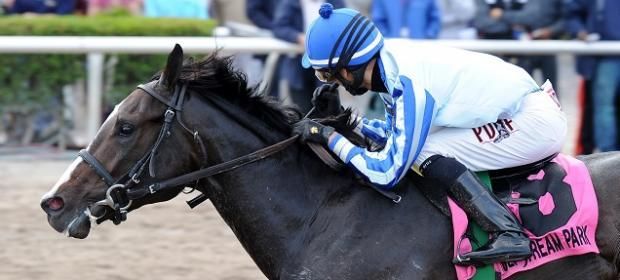
Upstart has displayed a flexible racing style in his short career. In his 2 year old starts, Upstart was near the back of the pack in the opening fractions, usually passing horses on the outside nearing the stretch. In the Holy Bull, Upstart stalked the pace from 2nd and 3rd before bursting to the front at the top of the stretch. This flexible style should be helpful if the 3-year-old finds himself in the Kentucky Derby. Trainer Rick Violette, described Upstart: "good size, good temperament, and pretty much will do anything the rider wants in the afternoon. I think he's the right package, and we'll see."
Evans described the Holy Bull win as a "thrill" and says his family is "over the moon." But Evans, being a businessman, remains realistic. He recognizes that the Kentucky Derby is a "remote possibility." Evans explains: "the water gets deeper" and "the possibility of disappointment looms somewhat larger." Rather than developing "Derby fever," Evans suffers from anxiety because Upstart "will be facing tougher and tougher competition."
Evans got a taste of that disappointment in the Fountain of Youth. Upstart crossed the finish line first, 2 3/4 lengths in front of Itsaknockout, but he was disqualified to second place. In a controversial decision, the stewards ruled that Upstart drifted out, causing Itsaknockout to be steadied. Trainer, Rick Violette, expressed disappointment: “The horse ran great. We just don’t get credit for it.”
Evans has repelled offers to buy Upstart. After 50 years in the racing business, Evans realizes that this type of horse is irreplaceable. He has discussed the offers with his family, and says they "would be crushed if I sold… They'd rather have the ride than the money."
Ralph Evans has only been to one Kentucky Derby, and only because his daughter wanted to go in 1979. He has never been to the Preakness Stakes, but was at Pimlico when March Magic ran in the Black-Eyed Susan in 2000. Since he lives in the Northeast, Evans has been to the Belmont Stakes several times. Hopefully, Upstart will be the horse to take him to all three races in 2015.
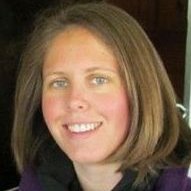
Jockey World Member Kristen Neiding started following horse racing after taking riding lessons during college at Miami University. She is now an attorney, focusing her practice in Equine Law. Every year during Kentucky Derby week, Kristen attends the National Conference on Equine Law in Lexington, Kentucky, hosted by the University of Kentucky. When not spending afternoons at her local racetrack, Thistledown, Kristen enjoys travelling to racetracks and horse farms in other states as far away as New York and Florida, or competing in local hunter jumper horse shows.
|
|
|
|
|
|
|
|
|
|
|
"Sheikh Mohammed bin Khalifa Al Maktoum"
April 24, 2015 by Kristen Neiding
 Our featured owner is a member of the ruling family of Dubai, but he is not the "Sheikh Mohammed" you're probably thinking of. Naturally, the first "Sheikh Mohammed" who comes to mind is Sheikh Mohammed bin Rashid Al Maktoum, Ruler of Dubai and Prime Minister of the United Arab Emirates, owner of Godolphin. Our featured owner, Sheikh Mohammed bin Khalifa Al Maktoum, is his first cousin. Our featured owner is a member of the ruling family of Dubai, but he is not the "Sheikh Mohammed" you're probably thinking of. Naturally, the first "Sheikh Mohammed" who comes to mind is Sheikh Mohammed bin Rashid Al Maktoum, Ruler of Dubai and Prime Minister of the United Arab Emirates, owner of Godolphin. Our featured owner, Sheikh Mohammed bin Khalifa Al Maktoum, is his first cousin.
Since most of our Jockey World readers are Americans, and may be unfamiliar with the vernacular of the UAE, here's a crash course in understanding the names. "Sheikh" is a title, referring to a leader. "Mohammed" is the man's first name. "Bin" is like "by" in our horse terminology. We would say that Zenyatta is "by" Street Cry, meaning that Street Cry is her father. Likewise, "bin Khalifa" means that Khalifa is his father. "Al Maktoum" means "of the Maktoum family," in American terminology, "Maktoum" would simply be his last name. So, putting that all together, his name would read "Leader, Mohammed, son of Khalifa, of the Maktoum family."
Sheikh Mohammed bin Khalifa Al Maktoum is Dubai's Minister of Land Affairs, a role which oversees issues such as building, growth, and tourism. Dubai's economy actually relies more heavily on these items than on oil. Sheikh Mohammed bin Khalifa says: "Dubai will not stop growing," and this emphasis on the city's growth is obvious from comparing today's city to pictures from a decade ago. (Pictured above, right, a photo comparison of Dubai a decade ago to current day)
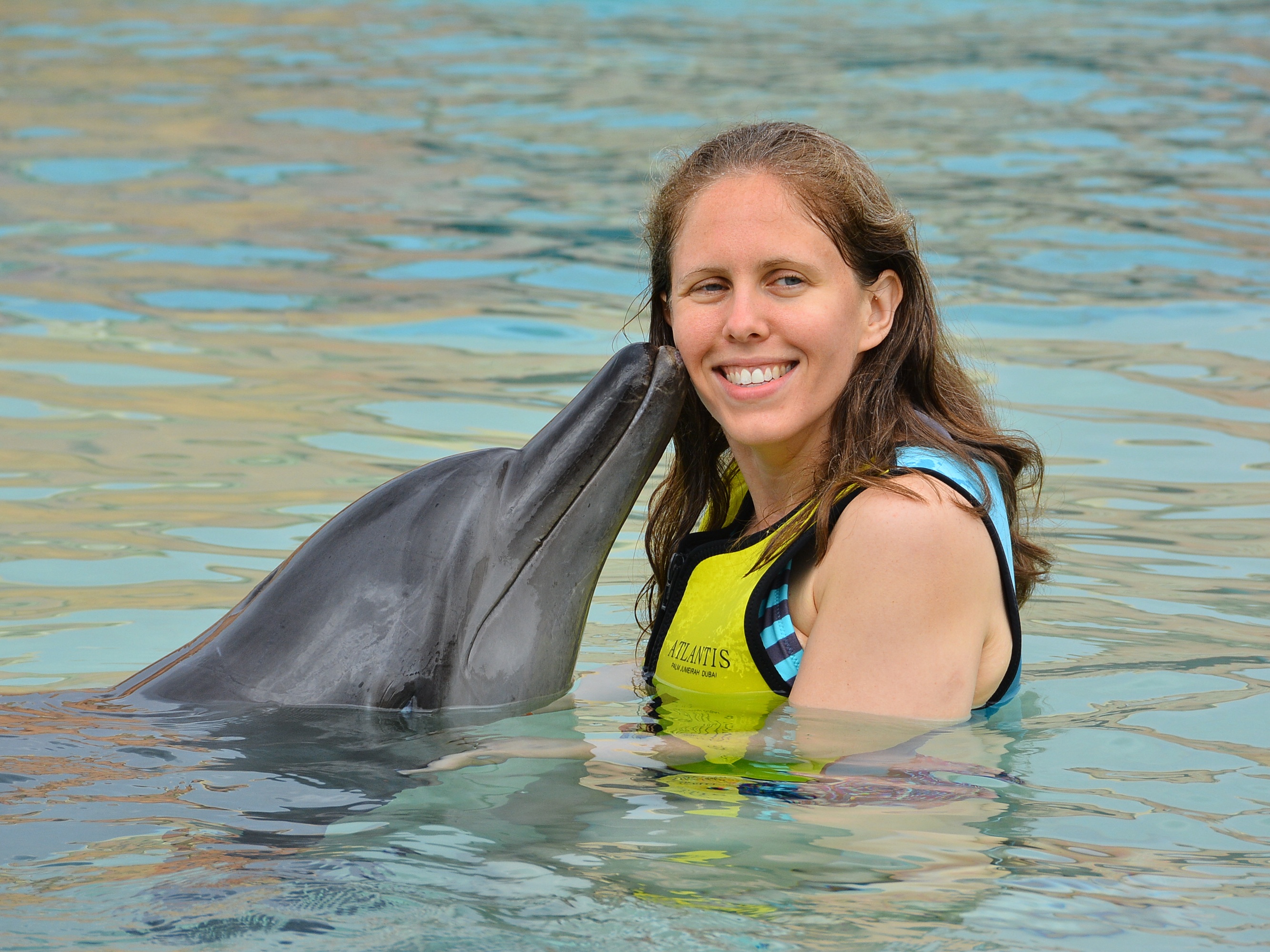 Dubai is not only expanding, but becoming a destination; a place that people want to visit. Tourists can shop at the world's largest mall, ride the world's fastest elevator to the top of the world's tallest building, tour an aquarium, and see a dinosaur all in one afternoon, all without stepping outside! At the Atlantis resort on the man-made island in the shape of a palm tree, visitors can ride water slides and swim with dolphins. In thoroughbred racing terms, Dubai's Meydan Racecourse is unparalleled, with air conditioned horse stalls, a mile long grandstand, complete with a hotel, an IMAX theater, a racing museum, and a rooftop swimming pool. Dubai is a city where tourists are welcomed and honored, where natives of Western culture can feel comfortable in an Arabic nation. Sheikh Mohammed bin Khalifa explains: "We have stable traditional rule in Dubai with no political upheaval, and we achieve harmony by making people feel welcome in our land." (Pictured right, featured writer Kristen Neiding, swimming with the dolphins while in Dubai for the World Cup - Photo Courtesy Kristen Neiding) Dubai is not only expanding, but becoming a destination; a place that people want to visit. Tourists can shop at the world's largest mall, ride the world's fastest elevator to the top of the world's tallest building, tour an aquarium, and see a dinosaur all in one afternoon, all without stepping outside! At the Atlantis resort on the man-made island in the shape of a palm tree, visitors can ride water slides and swim with dolphins. In thoroughbred racing terms, Dubai's Meydan Racecourse is unparalleled, with air conditioned horse stalls, a mile long grandstand, complete with a hotel, an IMAX theater, a racing museum, and a rooftop swimming pool. Dubai is a city where tourists are welcomed and honored, where natives of Western culture can feel comfortable in an Arabic nation. Sheikh Mohammed bin Khalifa explains: "We have stable traditional rule in Dubai with no political upheaval, and we achieve harmony by making people feel welcome in our land." (Pictured right, featured writer Kristen Neiding, swimming with the dolphins while in Dubai for the World Cup - Photo Courtesy Kristen Neiding)
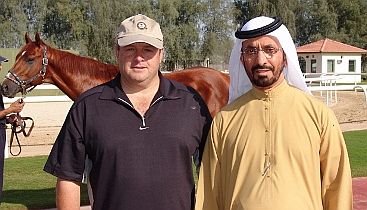 Sheikh Mohammed bin Khalifa initially was not interested in thoroughbred racing. He trained and raced Arabian horses in endurance races, and trained camels as well. "It was only when Sheikh Hamdan gave me four horses as gifts back in 1996 that my interest was kindled." Through the 2000s, his interest grew, and he expanded his operation, named Al Adiyaat. South African trainer, Mike de Kock, was recommended to the Sheikh, and de Kock's first suggestion was for Sheikh Mohammed bin Khalifa to purchase Candy Critic. In her first start for the Sheikh, the filly won the South African Oaks. Although de Kock has a more outspoken personality than the Sheikh, they get along quite well. Sheikh Mohammed bin Khalifa describes the trainer: “He is a teacher, he is a superstar, perhaps the best in the world.” (Pictured left, Sheikh Mohammed bin Sheikh Mohammed bin Khalifa initially was not interested in thoroughbred racing. He trained and raced Arabian horses in endurance races, and trained camels as well. "It was only when Sheikh Hamdan gave me four horses as gifts back in 1996 that my interest was kindled." Through the 2000s, his interest grew, and he expanded his operation, named Al Adiyaat. South African trainer, Mike de Kock, was recommended to the Sheikh, and de Kock's first suggestion was for Sheikh Mohammed bin Khalifa to purchase Candy Critic. In her first start for the Sheikh, the filly won the South African Oaks. Although de Kock has a more outspoken personality than the Sheikh, they get along quite well. Sheikh Mohammed bin Khalifa describes the trainer: “He is a teacher, he is a superstar, perhaps the best in the world.” (Pictured left, Sheikh Mohammed bin 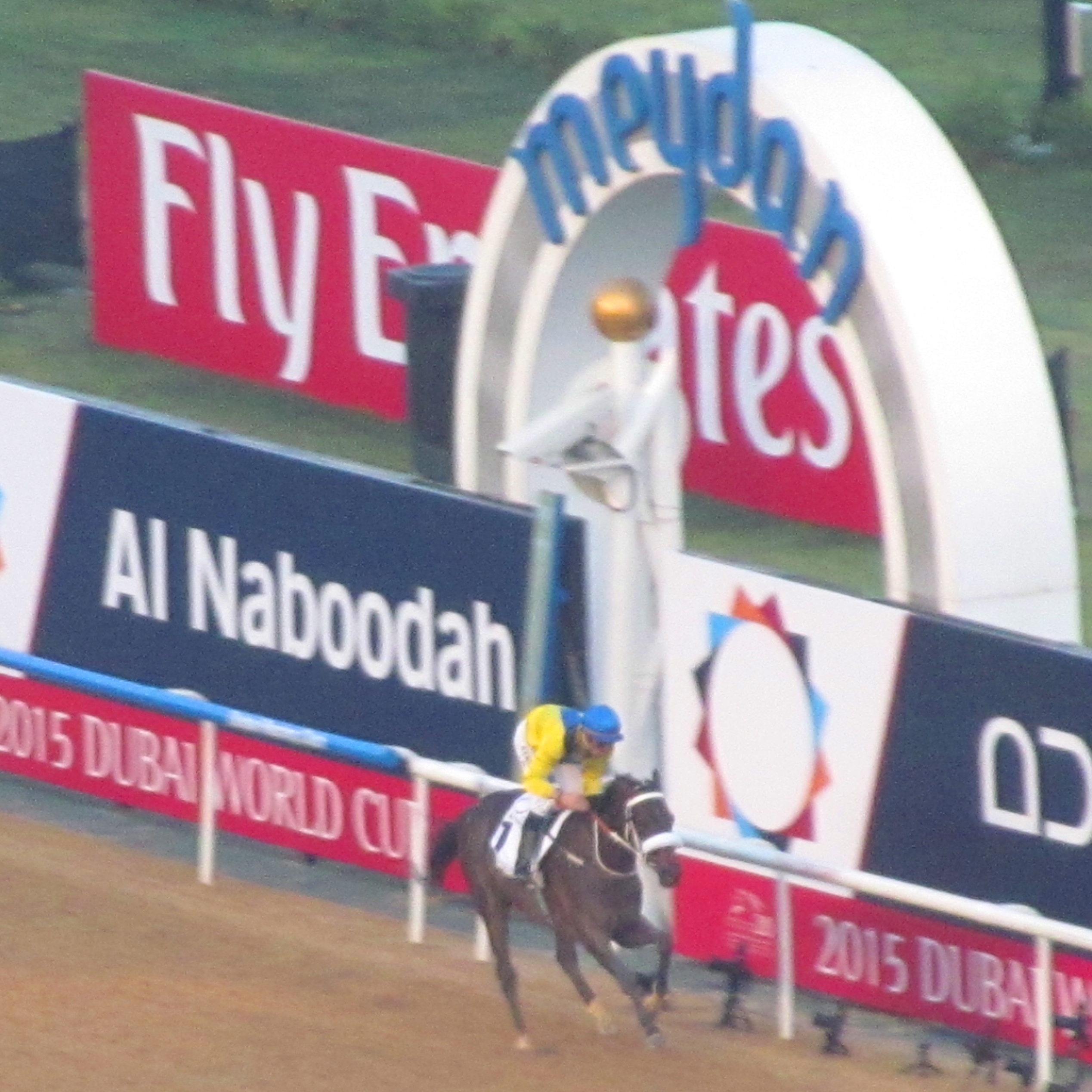 Khalifa Al Maktoum on the right, with his trainer Mike de Kock on the left) Khalifa Al Maktoum on the right, with his trainer Mike de Kock on the left)
In 2006, Sheikh Mohammed was interested in purchasing a horse named Husson, and sent De Kock to Argentina to make the deal. After some disagreement over price, the transaction fell through, but De Kock secured a deal on Asiatic Boy instead. The following spring, Asiatic Boy won the UAE Derby, and the next year finished second to Curlin in the Dubai World Cup. He won the UAE Derby again in 2008 with Honour Devil. That year, Sheikh Mohammed bin Khalifa also had Archipenko win in three different countries. He was quite the world traveler, winning at Ascot, Nad Al Sheba, and Sha Tin, and he also finished second in the Arlington Million. Next weekend, Sheikh Mohammed bin Khalifa looks posed to win the Kentucky Derby with Mubtaahij, after his dominant performance in the UAE Derby. (Pictured right, Kentucky Derby contender, Mubtaahij, crossing the wire in front during the UAE Derby - Photo Courtesy Kristen Neiding)
 Sheikh Mohammed bin Khalifa Al Maktoum speaks of his horse racing goals: "It is the aim of Al Adiyaat to buy horses anywhere in the world, it doesn't matter where. If Mike finds the right ones, we will buy them as we'd like to win big races all over the world, in the UK, the USA, Australia, and South Africa!" Speaking about any kind of rivalry with his cousin's Godolphin operation, Sheikh Mohammed bin Khalifa says he would be happy if Al Adiyaat grew to be as prominent as Godolphin, but: "there will never be a contest for glory or world racing domination between myself and His Highness Sheikh Mohammed bin Rashid Al Maktoum. We are healthy competitors on the racetrack, like we were years ago when we rode against each other in endurance races. But that is where it stops. Sheikh Mohammed bin Rashid does everything to the glory of God and Dubai and so do I. If he were to come to me tomorrow and asked if he could have my horse Honour Devil for Godolphin, I will oblige, I will give the horse to him. All to the glory of Dubai!" (Photo right, Meydan Racecourse - Photo Courtesy Kristen Neiding) Sheikh Mohammed bin Khalifa Al Maktoum speaks of his horse racing goals: "It is the aim of Al Adiyaat to buy horses anywhere in the world, it doesn't matter where. If Mike finds the right ones, we will buy them as we'd like to win big races all over the world, in the UK, the USA, Australia, and South Africa!" Speaking about any kind of rivalry with his cousin's Godolphin operation, Sheikh Mohammed bin Khalifa says he would be happy if Al Adiyaat grew to be as prominent as Godolphin, but: "there will never be a contest for glory or world racing domination between myself and His Highness Sheikh Mohammed bin Rashid Al Maktoum. We are healthy competitors on the racetrack, like we were years ago when we rode against each other in endurance races. But that is where it stops. Sheikh Mohammed bin Rashid does everything to the glory of God and Dubai and so do I. If he were to come to me tomorrow and asked if he could have my horse Honour Devil for Godolphin, I will oblige, I will give the horse to him. All to the glory of Dubai!" (Photo right, Meydan Racecourse - Photo Courtesy Kristen Neiding)

Jockey World Member Kristen Neiding started following horse racing after taking riding lessons during college at Miami University. She is now an attorney, focusing her practice in Equine Law. Every year during Kentucky Derby week, Kristen attends the National Conference on Equine Law in Lexington, Kentucky, hosted by the University of Kentucky. When not spending afternoons at her local racetrack, Thistledown, Kristen enjoys travelling to racetracks and horse farms in other states as far away as New York and Florida, or competing in local hunter jumper horse shows.
|
|
|
|
|
|
|
|
|
|
|
"Willis Horton"
January 23, 2015 by Kristen Neiding
 In the weeks leading up to the Eclipse Awards, most fans were looking forward to two things: who would win Horse of the Year, and another acceptance speech by Willis Horton. When he accepted the 2013 Champion 3-Year-Old Male award for Will Take Charge, Willis Horton entertained the audience by poking fun at himself and holding the stage long after the music played; then the crowd gave him a standing ovation for his efforts. In the weeks leading up to the Eclipse Awards, most fans were looking forward to two things: who would win Horse of the Year, and another acceptance speech by Willis Horton. When he accepted the 2013 Champion 3-Year-Old Male award for Will Take Charge, Willis Horton entertained the audience by poking fun at himself and holding the stage long after the music played; then the crowd gave him a standing ovation for his efforts.
Willis Horton hails from a small town in Arkansas, where he’s worn many hats throughout the years: parts store owner, turkey farmer, feed mill owner, and Searcy County Judge, but the career he’s most known for is turning his family’s construction business into D.R. Horton, America’s largest home builder.
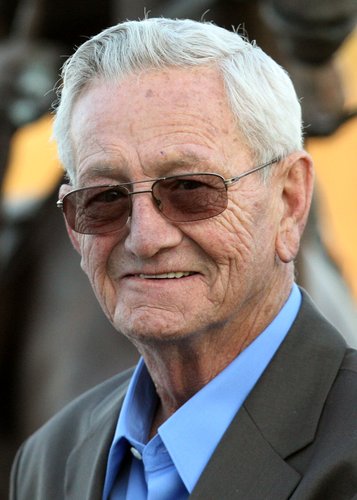 Horton had horses as a child, and always wanted to own racehorses, so when he retired from the construction business he entered the racing business. Although he knows it’s a business, Horton refers to racing as a hobby: “It’s the only thing that I do that I enjoy.” Although Oaklawn Park is about 2 hours and 20 minutes from his home, Horton regularly makes the drive. Horton had horses as a child, and always wanted to own racehorses, so when he retired from the construction business he entered the racing business. Although he knows it’s a business, Horton refers to racing as a hobby: “It’s the only thing that I do that I enjoy.” Although Oaklawn Park is about 2 hours and 20 minutes from his home, Horton regularly makes the drive.
Willis Horton’s first horse was named Zack Ridge Road; Ridge being the road he lived on, and Zack being the city he lived in. Horton’s horses were not initially successful, and he walked into Churchill Downs one day with the mindset of transferring his horses to “the first good trainer we run into.” Well, Willis Horton met D. Wayne Lukas on a staircase, and so began their long relationship. Horton helped Lukas’ assistant, Dallas Stewart, begin his own training career, and transferred his horses to Stewart for a time, but returned to Lukas in 2012.
Through the years, Horton has campaigned many horses. His first Breeders’ Cup horse was Partner’s Hero, who won five stakes in his career, but finished 8th in the 1998 Breeders’ Cup Sprint. Lemons Forever surprised the 2006 Kentucky Oaks field with her last-to-first stretch run, as the longest price on the board. The Oaks was her only stakes win, but she danced the big dances, and consistently earned a check, including for her 5th place finish in the 2006 Breeders’ Cup Distaff.
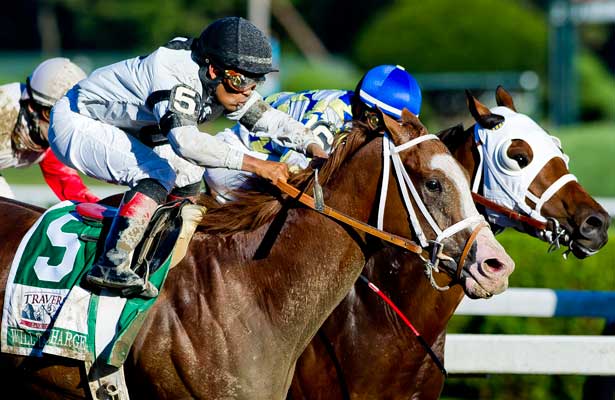 Those were a couple of nice horses, but nothing compared to the stars he campaigned in recent years. Will Take Charge stamped himself as a Kentucky Derby contender with wins in the Smarty Jones and Rebel Stakes. Another horse interfered with him in the stretch of the Kentucky Derby, so Will Take Charge actually ran better than his 8th place finish would suggest. He ran poorly in the other Triple Crown races, but returned to form in the summer, running 2nd in the Jim Dandy, then winning the Travers and Pennsylvania Derby. His rally in the Breeders’ Cup Classic looked like a winning one, but Mucho Macho Man managed to hold off the big chestnut colt, and Will Take Charge settled for 2nd. Those were a couple of nice horses, but nothing compared to the stars he campaigned in recent years. Will Take Charge stamped himself as a Kentucky Derby contender with wins in the Smarty Jones and Rebel Stakes. Another horse interfered with him in the stretch of the Kentucky Derby, so Will Take Charge actually ran better than his 8th place finish would suggest. He ran poorly in the other Triple Crown races, but returned to form in the summer, running 2nd in the Jim Dandy, then winning the Travers and Pennsylvania Derby. His rally in the Breeders’ Cup Classic looked like a winning one, but Mucho Macho Man managed to hold off the big chestnut colt, and Will Take Charge settled for 2nd.
Knowing that the Eclipse Award for Champion 3-year-old Male was within their grasp, Horton and Lukas sent Will Take Charge to the Grade 1 Clark Handicap to face Game On Dude. The race was everything it was supposed to be, with Game On Dude on the lead, and Will Take Charge galloping hard through the stretch. Will Take Charge stuck his head in front at the wire, winning both the Clark and the Eclipse Award simultaneously. “It was absolutely exciting... We fought so hard for it,” Horton later said. “I think that the Clark Handicap at Churchill Downs after the Breeders’ Cup put the lock on it for us.” Horton says he always had confidence in Will Take Charge, and sums his losses up to the colt’s size: “He was such a big, growthy horse that needed the time to grow into his body. He always had a good mind, and was always a good-looking horse, but just had to mature.”
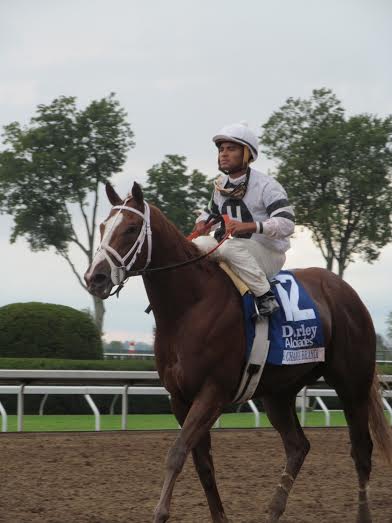 In June 2014, a white-faced chestnut filly sprinted gate to wire to break her maiden at first asking. Her dam is a half sister to Will Take Charge, and Willis Horton named her after his granddaughter, Brandi. After her maiden win, Take Charge Brandi went straight for stakes company, and qualified for the Breeders’ Cup. Her record was not spectacular, and she was dismissed by the bettors, making her 60-1, the longest price in the race. Victor Espinoza took her right to the front, and she didn’t look back. Horton and Lukas realized that this win put Take Charge Brandi in contention for the Eclipse Award, so they followed the same path that worked with Will Take Charge the previous year. They sent Take Charge Brandi to the Delta Princess and the Starlet Stakes, so she finished the year with 3 wins in a row, guaranteeing her the Champion 2-Year-Old Filly title over the talented turf filly, Lady Eli. (Photo right, courtesy of Kristen Neiding, "Take Charge Brandi" at Keeneland Race Course for the Alcibiades Stakes) In June 2014, a white-faced chestnut filly sprinted gate to wire to break her maiden at first asking. Her dam is a half sister to Will Take Charge, and Willis Horton named her after his granddaughter, Brandi. After her maiden win, Take Charge Brandi went straight for stakes company, and qualified for the Breeders’ Cup. Her record was not spectacular, and she was dismissed by the bettors, making her 60-1, the longest price in the race. Victor Espinoza took her right to the front, and she didn’t look back. Horton and Lukas realized that this win put Take Charge Brandi in contention for the Eclipse Award, so they followed the same path that worked with Will Take Charge the previous year. They sent Take Charge Brandi to the Delta Princess and the Starlet Stakes, so she finished the year with 3 wins in a row, guaranteeing her the Champion 2-Year-Old Filly title over the talented turf filly, Lady Eli. (Photo right, courtesy of Kristen Neiding, "Take Charge Brandi" at Keeneland Race Course for the Alcibiades Stakes)
Willis Horton again accepted the Eclipse Award, and did not disappoint his fans. Horton joked about needing a small bulldozer to get him off the stage, and he did a little dance while making his way to the podium. Horton summed up the 2014 racing season perfectly: “We have rode the gravy train, and we love it!”

Jockey World Member Kristen Neiding started following horse racing after taking riding lessons during college at Miami University. She is now an attorney, focusing her practice in Equine Law. Every year during Kentucky Derby week, Kristen attends the National Conference on Equine Law in Lexington, Kentucky, hosted by the University of Kentucky. When not spending afternoons at her local racetrack, Thistledown, Kristen enjoys travelling to racetracks and horse farms in other states as far away as New York and Florida, or competing in local hunter jumper horse shows.
|
|
|
|
|
|
|
|
|
|
|
Stavros Niarchos, Flaxman Holdings Ltd.
November 22, 2014 by Kristen Neiding
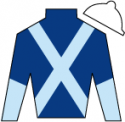 The Breeders' Cup World Championships. Winners of these races can come from anywhere. A colt bred in Japan out of a Sunday Silence mare, who did his racing in France, was a surprise winner of the 2014 Mile. A five year old Kentucky bred spent three years racing in Europe before returning to the US to dominate the New York turf division before winning the Breeders' Cup Turf. The Breeders' Cup World Championships. Winners of these races can come from anywhere. A colt bred in Japan out of a Sunday Silence mare, who did his racing in France, was a surprise winner of the 2014 Mile. A five year old Kentucky bred spent three years racing in Europe before returning to the US to dominate the New York turf division before winning the Breeders' Cup Turf.
As Americans, we tend to think of the Breeders' Cup as the Eclipse Awards Championships. In the weeks leading up to the races this year, there was much discussion about the four three year old colts in the Classic, and the implications for Horse of the Year. We expected the Classic to give us an answer about which horse was best, but although Bayern won the race, the interference at the start of the race left us questioning whether he was deserving of the Eclipse Award. So, most of the talk after the races has been the same as before the races… "Which horse has the best credentials?"
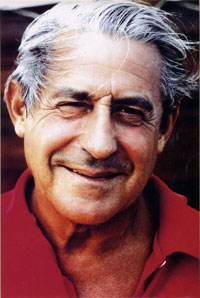 With so much focus on the Classic three year olds, some of the other storylines were lost. For instance, did you realize that the Japan-bred winner of the Mile, and the dominant New York turf horse share something in common? Something they also share with two-time Mile winner, Miesque, and champion sire Nureyev? They all campaigned under owner Stavros Niarchos, or his banner, Flaxman Holdings Ltd. With so much focus on the Classic three year olds, some of the other storylines were lost. For instance, did you realize that the Japan-bred winner of the Mile, and the dominant New York turf horse share something in common? Something they also share with two-time Mile winner, Miesque, and champion sire Nureyev? They all campaigned under owner Stavros Niarchos, or his banner, Flaxman Holdings Ltd.
Stavros Niarchos was born in Athens, Greece, in 1909. He studied law at the University of Athens before becoming involved in his family's grain business. During the 1930s, he realized that their business could retain more of its profits by owning their own ships rather than paying for their grain to be transported. When Greece entered World War II, Niarchos joined the Royal Hellenic Navy, and his grain ships were used in the war. He collected insurance for the ships that were destroyed, and used the money to buy better ships. His savvy business acumen made him enormously wealthy, and eventually he owned an art collection, lavish homes in several countries, and a private island off the coast of Greece.
Niarchos began dabbling in horse racing in the 1950s, and had a couple of third place finishes in the 2000 Guineas, but he lost interest in the sport until the 1970s. In 1978, he made a splash at the Keeneland Yearling Sale by bidding $1.3 million on a son of Northern Dancer. The colt, Nureyev, was the second highest priced yearling in history. Nureyev made his first start the following year and did not disappoint, winning the race by an easy six lengths. A couple months down the road saw him remain undefeated in the first start of his three year old season, before running in the 2000 Guineas.
 Nureyev had the inside post and broke last, putting him on the rail at the back of the pack. Jockey Philippe Pacquet guided Nureyev through the wall of horses and burst to the front. Known Fact and Posse made good runs, and together the three horses distanced themselves from the field. Nureyev finished strong, winning the race by a half length. In a turn of events similar to our Breeders' Cup Classic this year, the stewards were left to determine whether to name Nureyev the official winner, or to disqualify him for interference which took place midrace when he came through the field from last to first. In a highly controversial call, the stewards disqualified Nureyev, posting second place finisher, Known Fact, as the winner, and placing Nureyev last of all. Nureyev had the inside post and broke last, putting him on the rail at the back of the pack. Jockey Philippe Pacquet guided Nureyev through the wall of horses and burst to the front. Known Fact and Posse made good runs, and together the three horses distanced themselves from the field. Nureyev finished strong, winning the race by a half length. In a turn of events similar to our Breeders' Cup Classic this year, the stewards were left to determine whether to name Nureyev the official winner, or to disqualify him for interference which took place midrace when he came through the field from last to first. In a highly controversial call, the stewards disqualified Nureyev, posting second place finisher, Known Fact, as the winner, and placing Nureyev last of all.
Nureyev caught a virus while training for the Epsom Derby, and was ultimately retired. He stood his first season at stud at Haras de Fresnay-le-Buffard, Niarchos' farm in France, before being syndicated and sent to Walmac Farm in Kentucky.
 The sting of Nureyev's disqualification was eventually soothed by Niarchos' success. He became involved in partnerships with Coolmore horses, and according to a 1992 Vanity Fair article, he had over 100 horses, worth "several hundred million dollars." One of the most notable was Nureyev's daughter, Miesque. The sting of Nureyev's disqualification was eventually soothed by Niarchos' success. He became involved in partnerships with Coolmore horses, and according to a 1992 Vanity Fair article, he had over 100 horses, worth "several hundred million dollars." One of the most notable was Nureyev's daughter, Miesque.
Miesque was bred by Niarchos and foaled in Kentucky. In her first Group 1 race as a two year old, Miesque finished 3rd, which would be the worst finish of her career. She went on to win 12 of her 16 lifetime starts, all at the very highest level of competition in France, England, and the United States. Miesque capped her three year old season by winning the Breeders' Cup Mile in track record time at Hollywood Park. The following year Miesque successfully defended her Breeders' Cup Mile title at Churchill Downs, making her the first back-to-back winner in Breeders' Cup history. Miesque was given the Eclipse Award for Champion Female Turf Horse for her two Breeders' Cup victories in 1987 and 1988, and the corresponding awards in England and France. In total, Miesque was awarded ten championships and inducted into the United States Racing Hall of Fame in 1999.
As Stavros Niarchos' health began to wane, his daughter Maria took over management of the racing endeavors. Stavros Niarchos died in 1996, but the family's racing success continued when Spinning World won the Irish 2000 Guineas just a month later. He went on to win the Breeders' Cup Mile the .jpg) following year, a race the Niarchos family would win again in 2002, 2003, and with Karakontie in 2014. following year, a race the Niarchos family would win again in 2002, 2003, and with Karakontie in 2014.
The family maintains their breeding operation through the Oak Tree Division of Lane's End in Kentucky, in addition to their farm in France. Main Sequence was foaled at Oak Tree. He was the first foal for the Niarchos family mare, Ikat, by their multiple Grade 1 winner, Aldebaran. Main Sequence was a consistent performer in Europe, but blossomed when he returned to the United States where he began his US campaign in July of 2014, giving the Niarchos family their first win in the Breeders' Cup Turf. (Photo right courtesy of Jockey World member and featured writer Kristen Neiding)
Stavros Niarchos' life was well publicized, and he kept the reporters busy between his five marriages (two of which occurred simultaneously), and his rivalry with fellow Greek, Aristotle Onassis. But Niarchos’ horse racing endeavors mirrored his business success: whatever he touched would turn to gold.

Jockey World Member Kristen Neiding started following horse racing after taking riding lessons during college at Miami University. She is now an attorney, focusing her practice in Equine Law. Every year during Kentucky Derby week, Kristen attends the National Conference on Equine Law in Lexington, Kentucky, hosted by the University of Kentucky. When not spending afternoons at her local racetrack, Thistledown, Kristen enjoys travelling to racetracks and horse farms in other states as far away as New York and Florida, or competing in local hunter jumper horse shows.
|
|
|
|
|
|
|
|
|
|
|
Kaleem Shah
December 30, 2014 by Kristen Neiding
 Kaleem Shah was born in Southern India in 1962. His father, Majeed, and uncle, Saeed, were trainers. His father was very successful, one of the best trainers in India’s history. Majeed trained the winner of one Grade I race eleven years in a row, and he twice won the Indian Triple Crown. Despite his success, Majeed knew that most trainers struggled, so he advised Kaleem to focus on his studies and "should you be blessed with good fortune, if you want to own horses down the road, so be it." Kaleem Shah was born in Southern India in 1962. His father, Majeed, and uncle, Saeed, were trainers. His father was very successful, one of the best trainers in India’s history. Majeed trained the winner of one Grade I race eleven years in a row, and he twice won the Indian Triple Crown. Despite his success, Majeed knew that most trainers struggled, so he advised Kaleem to focus on his studies and "should you be blessed with good fortune, if you want to own horses down the road, so be it."
Kaleem earned a degree from Bangalore University in India before coming to the United States and earning a Master of Science from Clemson University, and an MBA from George Washington University. He founded a communications company in 1989, known as CalNet. After the 2001 terrorist attacks, the U.S. government became CalNet's main client. Shah explains: "We provide intelligence analysis, information technology support, and language services." Most of the work is classified, but Shah sums it up saying: "I'm very proud to serve our armed forces throughout the world." Kaleem Shah gave up his Indian citizenship to become an American citizen in the early 1990s. His patriotism is obvious from his red, white, and blue Stars-and-Stripes silks.
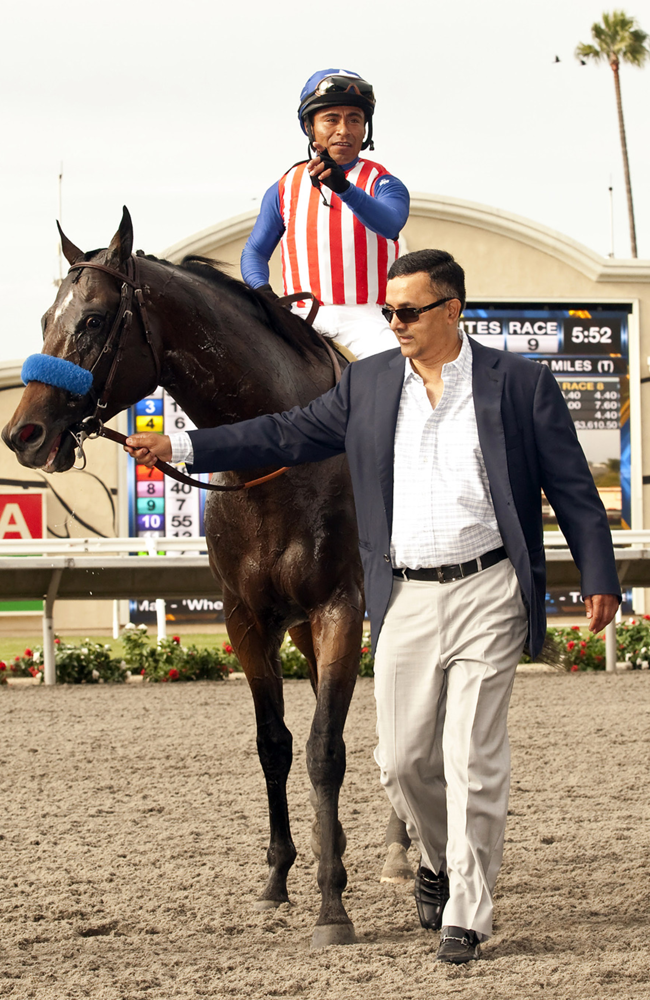 Kaleem Shah became involved in thoroughbred racing in 1996. He experienced moderate success with horses such as May Day Rose, Smash, Irrefutable, and Eden's Moon. In 2010, his Concord Point won the Iowa and West Virginia Derbies before an injury forced his retirement, and he now stands at Hill 'n' Dale Farm. Shah campaigned Fed Biz for four seasons and he has won multiple graded stakes, including the San Diego Handicap at Del Mar this summer, where the horse broke a track record which had been set by Zenyatta in 2008. Kaleem Shah became involved in thoroughbred racing in 1996. He experienced moderate success with horses such as May Day Rose, Smash, Irrefutable, and Eden's Moon. In 2010, his Concord Point won the Iowa and West Virginia Derbies before an injury forced his retirement, and he now stands at Hill 'n' Dale Farm. Shah campaigned Fed Biz for four seasons and he has won multiple graded stakes, including the San Diego Handicap at Del Mar this summer, where the horse broke a track record which had been set by Zenyatta in 2008.
The very next day, Shah flew to the east coast to witness Bayern, trained by succesful trainer Bob Baffert, win the Grade I Haskell Invitational Stakes, also in speedy, front-running fashion. The three year old colt was coming off a win in the Woody Stephens Stakes at Belmont Park, and would go on to set a track record in the Pennsylvania Derby. But his biggest win came upon his return to California, where he wired the star-studded field in the Breeders’ Cup Classic. That win catapulted Bayern into contention for the Eclipse Awards, and with six wins from ten races this season (including four graded stakes wins), he has a good shot.
Even if Bayern doesn’t get the nod, Kaleem Shah has a good two year old waiting in the wings. When the first Kentucky Derby future wager opened, Dortmund, a chestnut son of Big Brown with a maiden win at Santa Anita, was listed at 50-1. As the colt drew off in the stretch of an allowance race on Churchill Downs’ “Stars of Tomorrow” card, his odds dropped to 9-1, making him the favorite of the 23 individual entries, which included colts who have already successfully competed in graded stakes. Clearly, the backers who put $15,000 on Dortmund to win the Kentucky Derby believe the colt is something special!
Yet Shah won’t be terribly disappointed if Dortmund doesn’t win. He explained “I don’t get too upset when things go bad or we lose a race, and at the same time when you win, you don’t let yourself get too high.” Kaleem Shah developed this reasonable attitude early in life, through experience with his father’s horses.
Shah doesn’t mind investing large amounts of money into horses (like when he bought Azeri’s first foal for nearly $2 million), but he also doesn’t mind investing the time for them to become good, sound, healthy racehorses. “All horses need some time, otherwise, they get hurt and that benefits nobody.” Kaleem Shah was deeply saddened when his Irrefutable collapsed during unsaddling after finishing second in the Vernon O. Underwood at Hollywood Park. “I was raised around horses, so for a horse lover like me, losing a horse is the saddest part of horse racing. It hurts very much.” Shah puts the welfare of his equine athletes first: “I just want all the horses to stay healthy. As long as the horses stay sound, the wins will come.” This attitude is exactly what the horse racing industry needs. “The horses always come first.”

Jockey World Member Kristen Neiding started following horse racing after taking riding lessons during college at Miami University. She is now an attorney, focusing her practice in Equine Law. Every year during Kentucky Derby week, Kristen attends the National Conference on Equine Law in Lexington, Kentucky, hosted by the University of Kentucky. When not spending afternoons at her local racetrack, Thistledown, Kristen enjoys travelling to racetracks and horse farms in other states as far away as New York and Florida, or competing in local hunter jumper horse shows.
|
|
|
|
|
|
|
|
|
|
|
Sagamore Farm
Part 2: Kevin Plank
October 22, 2014 by Kristen Neiding
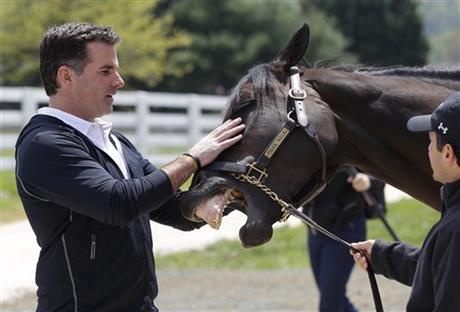 Kevin Plank first saw Sagamore Farm while riding his bicycle, and although he had no deep interest in racing or horses at the time, it caught his attention – the trees cleared, and there was the expanse of green pastures, white fencing, and the red roofed barns. Kevin Plank first saw Sagamore Farm while riding his bicycle, and although he had no deep interest in racing or horses at the time, it caught his attention – the trees cleared, and there was the expanse of green pastures, white fencing, and the red roofed barns.
At the time, Plank was focused on Under Armour, the sports apparel he invented. While Plank was playing college football, he was unsatisfied with cotton shirts, which get soaked with sweat, and become heavy and sticky. Plank knew that athletes needed a better product, so he invented Under Armour.
Likewise, Kevin Plank knew that Maryland needed horse racing, and in the mid-2000s, Maryland's horse racing industry was struggling. The Maryland native recognized the importance of the Preakness Stakes to the state: all eyes are on Maryland as the Kentucky Derby winner comes to town attempting to claim the second jewel of the Triple Crown. If Maryland were to lose horse racing, it would lose the Preakness Stakes, and with it, the opportunity to market their state to a national audience on the third Saturday in May.
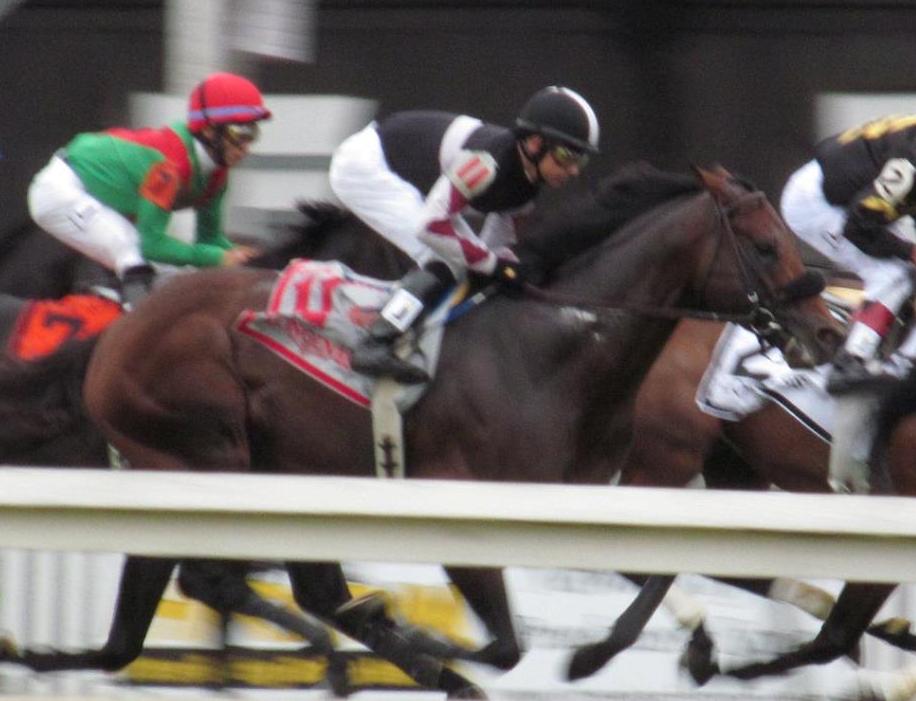 So Kevin Plank set out to buy a farm in Maryland, not because he had a lifelong love of horses, or because he was interested in growing his fortune through investing in thoroughbreds, but because he wanted to give a boost to the Maryland thoroughbred racing industry. Plank bought Sagamore Farm in 2007, hoping that his horses would be the “hometown team,” and that Maryland racing fans would rally behind them. (Photo right courtesy of Kristen Neiding) So Kevin Plank set out to buy a farm in Maryland, not because he had a lifelong love of horses, or because he was interested in growing his fortune through investing in thoroughbreds, but because he wanted to give a boost to the Maryland thoroughbred racing industry. Plank bought Sagamore Farm in 2007, hoping that his horses would be the “hometown team,” and that Maryland racing fans would rally behind them. (Photo right courtesy of Kristen Neiding)
Kevin Plank’s Under Armour Company is respected and trusted to produce quality products. He expects the same from his racing endeavor. Plank wants fans to know that Sagamore produces quality horses, who have quality people standing behind them, so fans can trust them, root for them, and bet on them. “I want that identity where people turn on the Kentucky Derby and say, ‘Is there a Sagamore horse? I like Sagamore horses, they are tough and gritty every time they run.’”
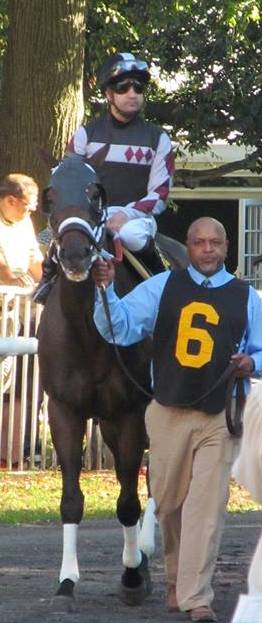 Usually it takes decades before a new owner finds success at the highest levels of thoroughbred racing, but Shared Account catapulted Kevin Plank into the Breeders’ Cup winners circle just three years after buying Sagamore, when she won the Breeders’ Cup Filly and Mare Turf in 2010. Tiger Walk became the first Sagamore horse to run in a Triple Crown race in the 2012 Preakness Stakes. Sagamore horses have been successful in stakes races up and down the east coast, including Happy My Way’s second place finish in the Grade I Alfred G. Vanderbilt Handicap at Saratoga in August 2014; fitting since the race was named after Sagamore Farm's previous owner. (Photo left courtesy of Kristen Neiding) Usually it takes decades before a new owner finds success at the highest levels of thoroughbred racing, but Shared Account catapulted Kevin Plank into the Breeders’ Cup winners circle just three years after buying Sagamore, when she won the Breeders’ Cup Filly and Mare Turf in 2010. Tiger Walk became the first Sagamore horse to run in a Triple Crown race in the 2012 Preakness Stakes. Sagamore horses have been successful in stakes races up and down the east coast, including Happy My Way’s second place finish in the Grade I Alfred G. Vanderbilt Handicap at Saratoga in August 2014; fitting since the race was named after Sagamore Farm's previous owner. (Photo left courtesy of Kristen Neiding)
Rooting for Sagamore Racing is like rooting for your hometown football team – players or horses come and go, but you’re still a fan of the team. Plank wants fans to identify with Sagamore: “I want people to recognize our silks and take pride when they see our silks run.” And that’s the way that Kevin Plank markets Sagamore, which has a strong social media presence. On their Facebook page, you can follow along as foals are born. You can vote in the cutest foal contest. You can suggest names for one of the foals, and win prizes if your suggestion is chosen. Every week they have Thursday Trivia, where they post a question relating to their farm, and people with the correct answer are entered to win a Sagamore/Under Armour (hat or t-shirt) item to be mailed to their home, along with a pamphlet about the farm.
Sagamore Farm also has a free fan club called the Three Diamonds Club. Members can participate in special Sagamore events like tours of the farm or the racetrack where their horses are stabled. Three Diamonds Club members are also invited to Sagamore Farm for the Speaker Series, where members of the racing community, like trainers or authors, share their personal stories, promote their books, and discuss the thoroughbred industry with the Three Diamonds Club members in attendance.
 As fans in the racing industry, we celebrate when owners are accommodating to the fans by letting us come see their horses or keeping us informed when they leave the track. But Sagamore goes beyond being accommodating -- they're inviting. Sagamore's goal is not just to campaign successful racehorses, their goal is also to get people involved in the sport. In this day and age of dwindling attendance and racetrack closures, the industry needs more owners with that mentality. It all started when Kevin Plank purchased Sagamore because he wanted to save thoroughbred racing in Maryland. Sagamore Farm's previous owner, Alfred Vanderbilt, was voted "The Man Who Did The Most for Racing" four times, and if there was an award today for the man doing the most for Maryland racing, Kevin Plank would undoubtedly be the winner. As fans in the racing industry, we celebrate when owners are accommodating to the fans by letting us come see their horses or keeping us informed when they leave the track. But Sagamore goes beyond being accommodating -- they're inviting. Sagamore's goal is not just to campaign successful racehorses, their goal is also to get people involved in the sport. In this day and age of dwindling attendance and racetrack closures, the industry needs more owners with that mentality. It all started when Kevin Plank purchased Sagamore because he wanted to save thoroughbred racing in Maryland. Sagamore Farm's previous owner, Alfred Vanderbilt, was voted "The Man Who Did The Most for Racing" four times, and if there was an award today for the man doing the most for Maryland racing, Kevin Plank would undoubtedly be the winner.

Jockey World Member Kristen Neiding started following horse racing after taking riding lessons during college at Miami University. She is now an attorney, focusing her practice in Equine Law. Every year during Kentucky Derby week, Kristen attends the National Conference on Equine Law in Lexington, Kentucky, hosted by the University of Kentucky. When not spending afternoons at her local racetrack, Thistledown, Kristen enjoys travelling to racetracks and horse farms in other states as far away as New York and Florida, or competing in local hunter jumper horse shows.
|
|
|
|
|
|
|
|
|
|
|
Sagamore Farm
Part 1: Alfred G. Vanderbilt, II
September 22, 2014 by Kristen Neiding
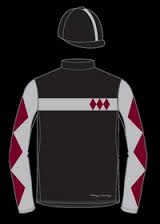 Pristine white barns with red roofs, immaculate white fences enclosing green pastures, a two-story watchtower overlooking an outdoor training track, and a quarter-mile indoor track for winter gallops, stalls which once housed countless champions, and a breeding shed where countless more were bred – it could be a description of any number of farms in bluegrass country, except that Sagamore Farm is 500 miles east of Lexington, Kentucky, less than a 30 minute drive from Pimlico Race Course in Maryland. The cerise and white diamond silks of Sagamore Farm are most associated with Alfred G. Vanderbilt, II, though the farm’s rich history began even before his birth. Pristine white barns with red roofs, immaculate white fences enclosing green pastures, a two-story watchtower overlooking an outdoor training track, and a quarter-mile indoor track for winter gallops, stalls which once housed countless champions, and a breeding shed where countless more were bred – it could be a description of any number of farms in bluegrass country, except that Sagamore Farm is 500 miles east of Lexington, Kentucky, less than a 30 minute drive from Pimlico Race Course in Maryland. The cerise and white diamond silks of Sagamore Farm are most associated with Alfred G. Vanderbilt, II, though the farm’s rich history began even before his birth.
Alfred Gwynne Vanderbilt II, was born in 1912, to Alfred Vanderbilt and Margaret Emerson Vanderbilt. Two and a half years later, his father set sail for England for a meeting of the directors of the International Horse Show Association, but never reached his destination – his vessel, the Lusitania, was torpedoed by a German U-boat. Three years earlier, Alfred Sr. had cancelled his passage on the Titanic after having a premonition the night before embarking.
Margaret Emerson Vanderbilt was the daughter of Isaac Emerson, inventor of Bromo Seltzer. Isaac Emerson invested some of his profits to begin Sagamore Farm, then gave the farm to Margaret. Isaac Emerson also took Alfred Vanderbilt II, to his first horse race – the 1923 Preakness Stakes. Alfred later described his experience: "Since the first time I went to the races at 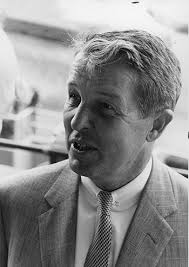 Pimlico at the age of 9, I have had this wonderful feeling about racing. I don't go to the races because I just love horses. It's like the person who goes to the circus and falls in love with the whole show, not just the elephants." After that, Alfred devoted his life to racing: taking Kentucky Derby wagers from his prep school classmates, and dropping out of Yale University after buying a filly on a whim at a Saratoga paddock sale. Pimlico at the age of 9, I have had this wonderful feeling about racing. I don't go to the races because I just love horses. It's like the person who goes to the circus and falls in love with the whole show, not just the elephants." After that, Alfred devoted his life to racing: taking Kentucky Derby wagers from his prep school classmates, and dropping out of Yale University after buying a filly on a whim at a Saratoga paddock sale.
Sagamore Farm was Alfred’s twenty-first birthday present from his mother. In his first year of ownership, Vanderbilt purchased a two year old colt named Discovery, with an eye toward the following year's three year old classic races. Discovery would finish second in the Kentucky Derby, and third in the Preakness, but more importantly, he became Sagamore Farm's foundation stallion. Discovery's daughter, Geisha, foaled a colt by Polynesian in 1950; the colt, Native Dancer, would be Alfred Vanderbilt's crowning achievement.
Native Dancer (shown below being lead into the winner's circle by Alfred Vanderbilt after the Belmont Stakes) won 21 of his 22 races; his only loss was a second place finish after a rough trip in the 1953 Kentucky Derby. Native Dancer was as popular as any horse in history: his face graced the cover of Time Magazine, and he’s known to be the first equine television star (his white face and shimmering gray coat made it easy for television viewers to root for him as he surged in the stretch). Native Dancer was champion two year old, champion three year old, and Horse of the Year, and he was wildly successful in the breeding shed, the majority of horses today can trace their lineage back to him.
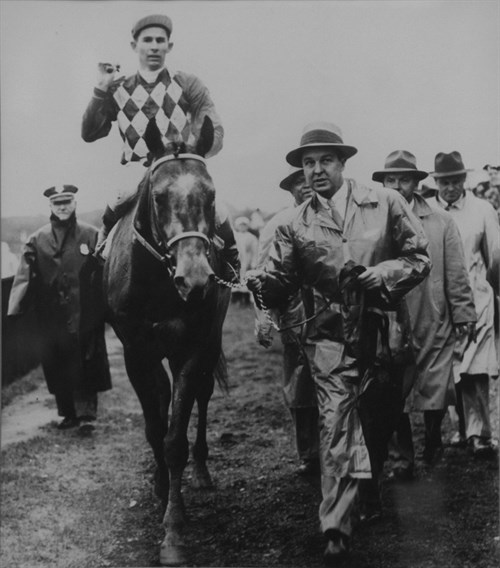 Along with Discovery and Native Dancer, Bed o’Roses was the third Sagamore Farm horse to be inducted into the National Museum of Racing and Hall of Fame. She was champion two year old filly, as well as champion older female at age four. She won the Matron Stakes at two years old, finished second to colts in the Travers at three, took the Comely at four, and won the Santa Margarita at age five. Like Native Dancer, Bed o’Roses' damsire was Discovery, confirming Vanderbilt’s breeding theory a success: “breed something to a Discovery mare,” or, more eloquently, “breed the best to the best, and hope for the best.” Along with Discovery and Native Dancer, Bed o’Roses was the third Sagamore Farm horse to be inducted into the National Museum of Racing and Hall of Fame. She was champion two year old filly, as well as champion older female at age four. She won the Matron Stakes at two years old, finished second to colts in the Travers at three, took the Comely at four, and won the Santa Margarita at age five. Like Native Dancer, Bed o’Roses' damsire was Discovery, confirming Vanderbilt’s breeding theory a success: “breed something to a Discovery mare,” or, more eloquently, “breed the best to the best, and hope for the best.”
Alfred Vanderbilt sold Sagamore in 1986, but continued going to the racetrack despite having lost his sight. In November 1999, Alfred attended morning workouts at Belmont Park, and died at home later that morning. During his life, he had been principal owner of Pimlico Race Course, as well as President of both Pimlico and Belmont Park. While serving as President of Pimlico in 1938, Vanderbilt arranged the famous match race between Seabiscuit and War Admiral for the inaugural running of the Pimlico Special. Alfred G. Vanderbilt, II, was voted “The Man Who Did The Most for Racing” a record four times by the New York Turf Writers, and the award was posthumously renamed in his honor. He is also honored with a race named after him at Saratoga Race Course.

Jockey World Member Kristen Neiding started following horse racing after taking riding lessons during college at Miami University. She is now an attorney, focusing her practice in Equine Law. Every year during Kentucky Derby week, Kristen attends the National Conference on Equine Law in Lexington, Kentucky, hosted by the University of Kentucky. When not spending afternoons at her local racetrack, Thistledown, Kristen enjoys travelling to racetracks and horse farms in other states as far away as New York and Florida, or competing in local hunter jumper horse shows.
|
|
|
|
|
|
|
|
|
|
|
The Evans Family
Buckland Farm - Thomas Mellon Evans
Spring Hill Farm - Edward P. Evans
Courtland Farm - Robert S. Evans
July 22, 2014 by Kristen Neiding
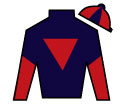 The Belmont Stakes: the test of the champion. The Belmont favorite had won the Kentucky Derby and Preakness Stakes, but came up about two lengths short in New York. The Belmont winner had not raced in the other Triple Crown races. Though separated by over three decades, the 1981 and 2014 Belmont Stakes share much in common. In 1981, Pleasant Colony's Triple Crown bid was thwarted by Summing. In 2014, Pleasant Colony's grandson, Tonalist, thwarted California Chrome's Triple Crown bid. The Evans family, which faced the utter disappointment of Pleasant Colony's loss in 1981, experienced the elation of winning with Tonalist, but Robert Evans wished his father and brother were still here to experience it with him. The Belmont Stakes: the test of the champion. The Belmont favorite had won the Kentucky Derby and Preakness Stakes, but came up about two lengths short in New York. The Belmont winner had not raced in the other Triple Crown races. Though separated by over three decades, the 1981 and 2014 Belmont Stakes share much in common. In 1981, Pleasant Colony's Triple Crown bid was thwarted by Summing. In 2014, Pleasant Colony's grandson, Tonalist, thwarted California Chrome's Triple Crown bid. The Evans family, which faced the utter disappointment of Pleasant Colony's loss in 1981, experienced the elation of winning with Tonalist, but Robert Evans wished his father and brother were still here to experience it with him.
The day before the Belmont Stakes, Robert went to a Connecticut cemetery: "I went to my father's grave and thanked him for putting me in the position to be doing this." Robert spoke of Pleasant Colony, and his family: "[Pleasant Colony] was a wonderful horse. And it's very satisfying to be able to make up for that. My brother was a great breeder and owner and did really well in the business. And so did my father… I've kind of tagged along behind them, but now they're both gone and I feel I have to fill their shoes, if I can."
Robert's father, Thomas Mellon Evans, owned Buckland Farm, which campaigned Pleasant Colony, among many other horses including two champions: two year old champion filly, Pleasant Stage, and champion older male, Pleasant Tap. Robert and brother, Edward, owned pieces of Pleasant Tap as well.
Edward "Ned" Evans owned Spring Hill Farm, mainly a breeding operation, which found a profitable balance between selling some foals at auction while racing others. Horses bred by Edward's Spring Hill Farm have earned over $75 million, and over 100 of those horses became stakes winners. Spring Hill Farm bred 2005 Horse of the Year, Saint Liam, but sold him at auction. Edward did, however, campaign homebred, Quality Road, who won numerous Grade 1 races, over $2.2 million, and broke the track record on more than one occasion. Spring Hill Farm was Virginia Breeder of the Year nine times in the course of eleven years, and national Breeder of the Year in 2009.
Robert "Shel" Evans owns Courtland Farm, in Easton, Maryland. Courtland Farm bred and raced recent talented horses Marsh Side and Lemon Drop Mom. Robert also bred a filly named Shared Interest, who won the Grade 1 Ruffian Handicap in 1993. Upon retirement, Shared Interest returned to Courtland Farm and produced Breeders Cup Juvenile Fillies winner, Cash Run, and King's Bishop winner turned successful sire, Forestry.
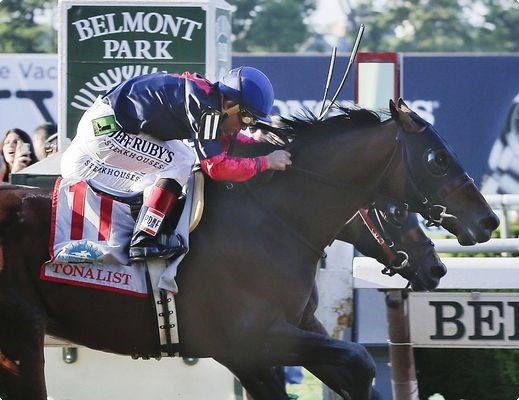 Like his brother had, Robert typically breeds horses to sell at auction. Tonalist is an exception. Robert sent his yearlings to the Fasig-Tipton Saratoga sale, and Tonalist ended up in the same barn as Robert's yearlings. Tonalist was going through an awkward growth spurt, and failed to meet his reserve in the sale. Robert describes what happened next: "Cathy Sweezey urged me 10 times probably to look at the horse and dragged me back… She said, ‘You’ve got to buy this horse. He didn’t sell, so they discounted him substantially.’ And I said, finally, ‘All right, I’ll buy him.’ She made me do it." Robert bought Tonalist partially because his dam, Settling Mist, was sired by his father's Triple Crown contender, Pleasant Colony. Like his brother had, Robert typically breeds horses to sell at auction. Tonalist is an exception. Robert sent his yearlings to the Fasig-Tipton Saratoga sale, and Tonalist ended up in the same barn as Robert's yearlings. Tonalist was going through an awkward growth spurt, and failed to meet his reserve in the sale. Robert describes what happened next: "Cathy Sweezey urged me 10 times probably to look at the horse and dragged me back… She said, ‘You’ve got to buy this horse. He didn’t sell, so they discounted him substantially.’ And I said, finally, ‘All right, I’ll buy him.’ She made me do it." Robert bought Tonalist partially because his dam, Settling Mist, was sired by his father's Triple Crown contender, Pleasant Colony.
And so, three decades after suffering the disappointment of defeat in the Belmont Stakes, the Evans family finally experienced vindication. This year, California Chrome was the biggest story of the Triple Crown season, and the story of how a couple of normal people bred an inexpensive horse and were lucky enough to win a series of very prestigious races, all on their first try. Their story stands in stark contrast to Belmont winner, Tonalist, whose 70 year old owner has been in the racing industry for 50 years, and had never before entered a horse in a Triple Crown race.
Immediately after the 1981 Belmont, Pleasant Colony's trainer, Johnny Campo, was interviewed by CBS. The reporter said "I'm sorry Johnny," to which he replied "don't be sorry, that's the name of the game." In 2014, Robert Evans' comments mirrored Campo's: "I would have liked for California Chrome to have the Triple Crown. It would have been great for racing, but you can't have a walkover. I'm sorry, but it's horse racing."
Evans concluded: "We loved California Chrome. We hoped he would win the Triple Crown. But we love our horse, too." I'm with you, Mr. Evans… I love both horses too!

Jockey World Member Kristen Neiding started following horse racing after taking riding lessons during college at Miami University. She is now an attorney, focusing her practice in Equine Law. Every year during Kentucky Derby week, Kristen attends the National Conference on Equine Law in Lexington, Kentucky, hosted by the University of Kentucky. When not spending afternoons at her local racetrack, Thistledown, Kristen enjoys travelling to racetracks and horse farms in other states as far away as New York and Florida, or competing in local hunter jumper horse shows.
|
|
|
|
|
|
|
|
|
|
|
Her Majesty, Queen Elizabeth ll
June 22, 2014 by Kristen Neiding
 The Sport of Kings. You know the phrase refers to horse racing, but few of us know the phrase as little more than a romantic notion, harkening back to a time represented in A Game of Thrones, conjuring images of kings in castles, nobility, tradition, hierarchy, the line of succession, and knights in shiny armor. After all, America has no kings; and therefore it's more foreign to us, not something we see or think about or are exposed to very often. The Sport of Kings. You know the phrase refers to horse racing, but few of us know the phrase as little more than a romantic notion, harkening back to a time represented in A Game of Thrones, conjuring images of kings in castles, nobility, tradition, hierarchy, the line of succession, and knights in shiny armor. After all, America has no kings; and therefore it's more foreign to us, not something we see or think about or are exposed to very often.
Likewise, the sport of kings in our country is a game for every man. Undeniably, we relish in stories of ordinary folks purchasing inexpensive horses, then rising to the highest levels of our sport, to win our most beloved races. And yet kings are still involved in horse racing, but in the US, our interaction with them is through stable names such as Godolphin, Darley, Shadwell, and Juddmonte. Unless we have a particular interest in, or a wager on, one of their horses, we don't particularly care whether they win or lose; we regard them the same as any other owner in the sport. In the UK, conversely, the most special days in racing are when their beloved Queen wins a major race.
Her Majesty, Queen Elizabeth II, was born April 21, 1926, and developed a love of horses not long after. At the ripe age of four, Queen Elizabeth, and her sister Margaret, received a gift of a Shetland pony, named Peggy. By the age of six, the future Queen was riding Peggy without assistance. The Queen developed a love of horse racing through her mother and father. King George VI owned thoroughbred racehorses, racing in the royal silks which were passed to him by his grandfather, King Edward VII. The silks feature a purple body, scarlet sleeves, and gold braiding; and the cap is black velvet with gold fringe. Those "registered colours" were passed to Elizabeth upon the King's death in 1952, along with a group of horses that he owned. The Queen Mother had a greater interest in National Hunt Racing, which we call steeplechase.
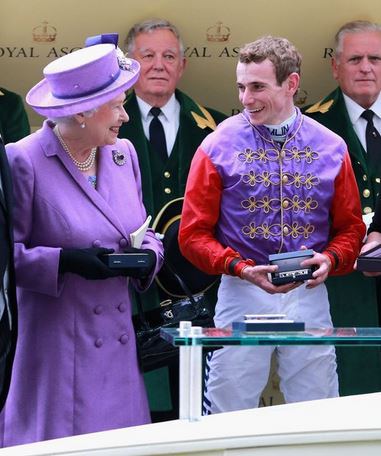 Elizabeth's first racehorse was a filly, named Astrakhan, given to her as a wedding present from the Aga Khan in 1948. Since then, she has had many horses and enjoyed much success. She's had over 1600 winners, including winning four of the five English Classics: the 1,000 Guineas, the 2,000 Guineas, the Epsom Oaks, and the St. Leger. The Epsom Derby is the only one of the five English Classics that has eluded her, though she did finish second in 1953, and third in 2011. She became the first reigning monarch ever to be British flat racing Champion Owner twice (in 1954 and 1957). Elizabeth's first racehorse was a filly, named Astrakhan, given to her as a wedding present from the Aga Khan in 1948. Since then, she has had many horses and enjoyed much success. She's had over 1600 winners, including winning four of the five English Classics: the 1,000 Guineas, the 2,000 Guineas, the Epsom Oaks, and the St. Leger. The Epsom Derby is the only one of the five English Classics that has eluded her, though she did finish second in 1953, and third in 2011. She became the first reigning monarch ever to be British flat racing Champion Owner twice (in 1954 and 1957).
You might expect a reigning monarch to delegate management of her racehorses, and be owner in name alone. For Queen Elizabeth II, that is not the case. On the contrary, the Queen thrives on personally managing the details of her horses. She is fascinated by breeding, and strives to breed the perfect racehorse. She inspects her foals personally. "She names all her own horses, I believe -- it gives her fantastic pleasure, planning the whole process," Nick Attenborough, spokesman for Great British Racing said. Her trainers and racing managers through the years have raved about how much she knows about her horses. Trainer Andrew Balding, stated: "She is a very well-informed and keen owner, probably the best-informed owner in the country." Captain Charles Moore, said: "She is most knowledgeable and is not an owner anyone can take liberties with." Indeed, Captain Moore witnessed her knowledge first hand in the 1938, when then 12 year old Elizabeth accompanied her father, King George VI, to inspect the foals at Sandringham. As the story goes, Captain Moore's memory failed him on the pedigree of one of the foals. The future queen spoke right up, spouting off not only the names of the sire and dam, but also what races they had won in their careers.
There's no hiding Queen Elizabeth's love of horse racing. After watching one of her horses win a major race, Elizabeth II declared: "It was the most tremendously exciting thing I ever saw." Nick Attenborough expressed just how lucky the racing industry is to have such a wonderful supporter: "Fantastic for us as she has to be the most high-profile figure in Great Britain with a standing all round the world and it is hard for any country in the world to have a more prominent figurehead in their sport."
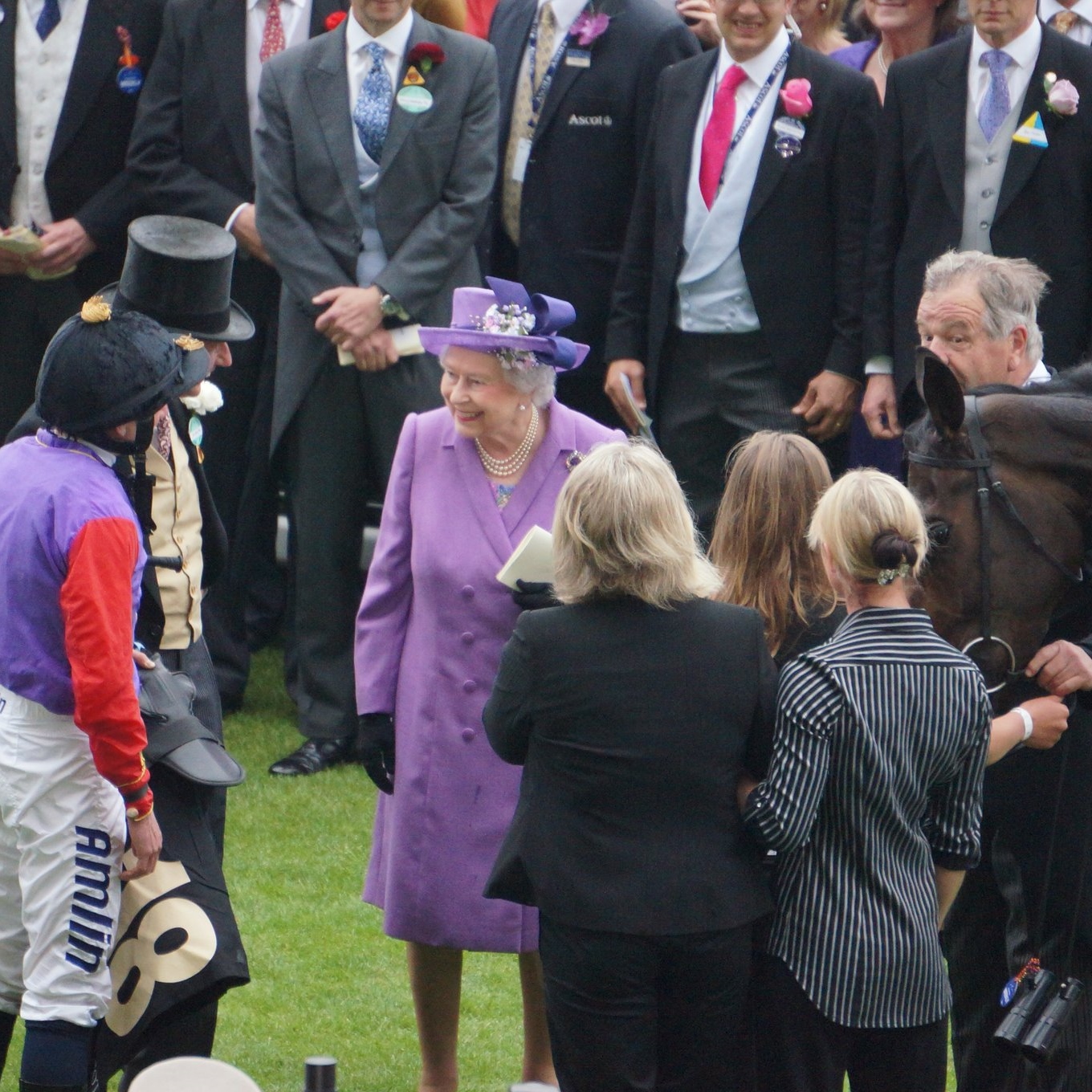 Undeniably, the Queen's brilliant smile as her filly, Estimate, won the Ascot Gold Cup last year (making Elizabeth the only reigning monarch to win the race) is evidence of her passion for horses. What makes her win even more special is that Queen Elizabeth is so beloved by her loyal subjects, and they delight in her success. The filly flashed under the line first, as the race caller announced: "It's a happy and glorious day at Royal Ascot, Estimate has won the Gold Cup for the Queen!" As the television coverage focused on the Queen's reaction during the race, a voice narrates: "Showing such passion and emotion during the closing stages, the Queen herself, demonstrated the excitement of racehorse ownership can affect even the coolest of exteriors!" Undeniably, the Queen's brilliant smile as her filly, Estimate, won the Ascot Gold Cup last year (making Elizabeth the only reigning monarch to win the race) is evidence of her passion for horses. What makes her win even more special is that Queen Elizabeth is so beloved by her loyal subjects, and they delight in her success. The filly flashed under the line first, as the race caller announced: "It's a happy and glorious day at Royal Ascot, Estimate has won the Gold Cup for the Queen!" As the television coverage focused on the Queen's reaction during the race, a voice narrates: "Showing such passion and emotion during the closing stages, the Queen herself, demonstrated the excitement of racehorse ownership can affect even the coolest of exteriors!"
As the coverage ended, John McCririck captured the moment perfectly: "She loves it! And the crowd know that she's really enjoying it, so it's absolutely fantastic!... Extraordinary expression of the public's affection for the monarchy, for the Queen, for the love of horses, and for horse racing itself! A day that anyone here will never, ever forget. It was magnificent! Racing at its finest, its most emotional, it tugged at you! And to be part of it: superb!"

Jockey World Member Kristen Neiding started following horse racing after taking riding lessons during college at Miami University. She is now an attorney, focusing her practice in Equine Law. Every year during Kentucky Derby week, Kristen attends the National Conference on Equine Law in Lexington, Kentucky, hosted by the University of Kentucky. When not spending afternoons at her local racetrack, Thistledown, Kristen enjoys travelling to racetracks and horse farms in other states as far away as New York and Florida, or competing in local hunter jumper horse shows.
|
|
|
|
|
|
|
|
|
|
|
Winchell Thoroughbreds, LLC
May 22, 2014 by Kristen Neiding
 What do Desi Arnaz, the world’s largest donut, Ronald Reagan, and Tapit have in common? Since you probably read the title of this article, you probably guessed Winchell Thoroughbreds. Congratulations, you are correct! What do Desi Arnaz, the world’s largest donut, Ronald Reagan, and Tapit have in common? Since you probably read the title of this article, you probably guessed Winchell Thoroughbreds. Congratulations, you are correct!
Winchell Thoroughbreds, LLC, is the horse racing endeavor of the Winchell family; husband and wife, Verne and Joan Winchell, and their son Ron Winchell. Though widely known for the recent success of their Tapit homebreds, Winchell Thoroughbreds dates back to the 1950s.
Verne Winchell was born in Bloomington, Illinois, in 1915, but his family moved to California when he was nine years old. On October 8, 1948, he opened a donut shop in Temple City, California. That single donut shop grew into an incredibly successful chain, Winchell's Donuts, which dubbed Verne Winchell as “the Donut King.” The Pasadena shop made the world’s largest donut in 1998; 95 feet tall, and 5,000 lbs! Verne Winchell eventually sold Winchell’s Donuts to Denny’s Restaurants, and became chairman of Denny’s until retiring in the 1980s, and selling his stock for $600 million.
Winchell became interested in horse racing in the 1930s. With the donut shop profits in the 1950s, he could finally make the step into ownership. One of his first horses was Ronnie’s Baby, who didn’t do much as a racehorse, but did have famous connections. The horse was bred by fellow actor/ future president, Ronald Reagan and was bought by Winchell from actor/bandleader, Desi Arnaz.
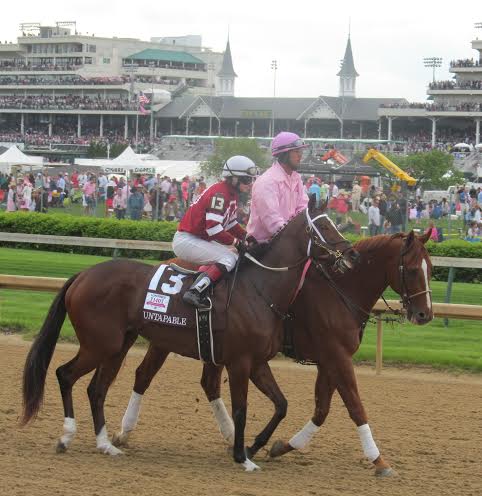 Winchell eventually found success in racing. He won the 1961 Champagne Stakes with a horse named for Verne Winchell, himself: Donut King. Although he ran third in the 1962 Wood Memorial, he sustained an injury prior to the Kentucky Derby. Winchell's first Kentucky Derby entrant was Classic Go Go in 1981, followed by two more in the 1990s, Valiant Nature and Sea Cadet. He had two champion horses: Mira Femme, 1966 Two Year Old Filly (co-champion); and Tight Spot, 1991 Turf Male. (Photo right courtesy of Kristen Neiding) Winchell eventually found success in racing. He won the 1961 Champagne Stakes with a horse named for Verne Winchell, himself: Donut King. Although he ran third in the 1962 Wood Memorial, he sustained an injury prior to the Kentucky Derby. Winchell's first Kentucky Derby entrant was Classic Go Go in 1981, followed by two more in the 1990s, Valiant Nature and Sea Cadet. He had two champion horses: Mira Femme, 1966 Two Year Old Filly (co-champion); and Tight Spot, 1991 Turf Male. (Photo right courtesy of Kristen Neiding)
Winchell expanded to breeding with Mira Loma Thoroughbred Farm in California, which he owned until purchasing Oakwind Farm in 1978. Oakwind Farm is north of Lexington, Kentucky, and has been renamed Corinthia Farm, though it still belongs to the Winchell family.
Verne Winchell passed away of a heart attack following his daily treadmill exercise at his home on November 26, 2002. Wife, Joan, and son, Ron, continued racing as Winchell Thoroughbreds, and Verne would be proud of their success.
Since Verne's passing, Winchell Thoroughbreds has started four horses in the Kentucky Derby (Tapit, 2004; Zanjero, 2007; Pyro, 2008; and Tapiture, 2014). They won their first Breeders' Cup race in 2012, when Tapizar won the Dirt Mile. They had previously finished second with Pyro in the 2007 Juvenile. This year, Winchell Thoroughbreds won their second Kentucky Oaks with Untapable (their first was Summerly in 2005). By earnings, Winchell Thoroughbreds has been ranked in the top 75 in four of the last ten years, and they're currently ranked fourth, with $1.71 million in earnings thus far in 2014.
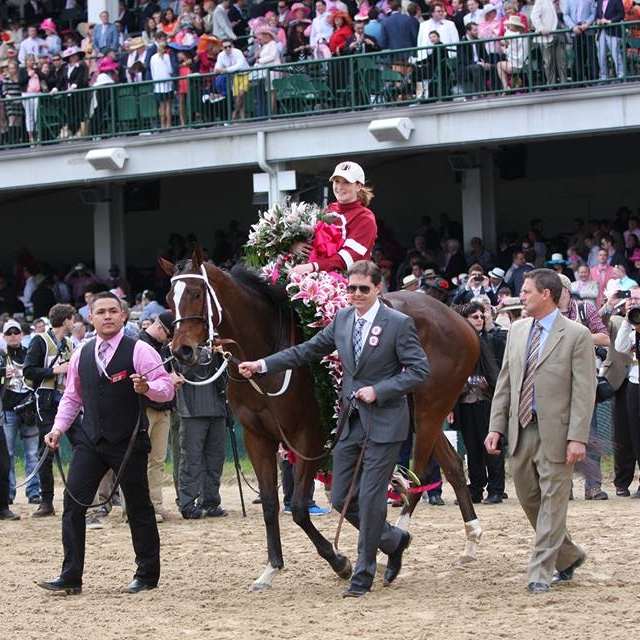 What makes their success even more gratifying, is that many of their successful racehorses are homebreds, whose pedigrees date back through several generations of Winchell racehorses. After the Kentucky Oaks, Ron Winchell spoke of Untapable's win: "This is special for many reasons. Tapit being the sire, of course. The mare being from a long line of family, from the breeding perspective. So very, very important to us." Farm manager, David Fiske, elaborated: "Untapable is about the fourth generation of fillies that we've had out of that family. "[Carols Christmas] was claimed by Ron's father in California. Then we raised [Bistra] and [Fun House], and Untapable herself at our farm in Lexington." Untapable's pedigree also features Winchell's first Kentucky Derby runner, Classic Go Go, and their 2004 stable star turned super-sire, Tapit. What makes their success even more gratifying, is that many of their successful racehorses are homebreds, whose pedigrees date back through several generations of Winchell racehorses. After the Kentucky Oaks, Ron Winchell spoke of Untapable's win: "This is special for many reasons. Tapit being the sire, of course. The mare being from a long line of family, from the breeding perspective. So very, very important to us." Farm manager, David Fiske, elaborated: "Untapable is about the fourth generation of fillies that we've had out of that family. "[Carols Christmas] was claimed by Ron's father in California. Then we raised [Bistra] and [Fun House], and Untapable herself at our farm in Lexington." Untapable's pedigree also features Winchell's first Kentucky Derby runner, Classic Go Go, and their 2004 stable star turned super-sire, Tapit.
Untapable's dam, Fun House, also produced a colt by El Prado in 2007. That colt was sold to Donegal Racing, and named Paddy O'Prado, who ran third in the 2010 Kentucky Derby.
Staying true to a sport that's always looking for lightning to strike twice, Fun House was bred back to Tapit on the morning of May 2, 2014, less than 12 hours before Untapable proved to be uncatchable in the Kentucky Oaks.

Jockey World Member Kristen Neiding started following horse racing after taking riding lessons during college at Miami University. She is now an attorney, focusing her practice in Equine Law. Every year during Kentucky Derby week, Kristen attends the National Conference on Equine Law in Lexington, Kentucky, hosted by the University of Kentucky. When not spending afternoons at her local racetrack, Thistledown, Kristen enjoys travelling to racetracks and horse farms in other states as far away as New York and Florida, or competing in local hunter jumper horse shows.
|
|
|
|
|
|
|
|
|
|
|
Morton Fink
April 24, 2014 by Kristen Neiding
 I met Morton Fink at the Eclipse Awards in 2013. He had just accepted Wise Dan's Champion Turf Male award, and we stopped him to ask for his autograph. Mr. Fink graciously consented, but asked to sit down while he signed. Though his body may be weak, Mr. Fink's enthusiasm for the Sport of Kings remains strong. I met Morton Fink at the Eclipse Awards in 2013. He had just accepted Wise Dan's Champion Turf Male award, and we stopped him to ask for his autograph. Mr. Fink graciously consented, but asked to sit down while he signed. Though his body may be weak, Mr. Fink's enthusiasm for the Sport of Kings remains strong.
Morton Fink is best known for campaigning Wise Dan, but he's been involved in the racing industry for almost half a century. Fink lives in Northbrook, Illinois, near Chicago. He earned a degree in business administration from Roosevelt University, before inheriting a movie theater business from his father. Fink sold the theaters to a national chain.
Fink developed an interest in horse racing when his mom took him to the racetrack as a child. Morton Fink remains a fixture at his local track, Arlington Park, but describes it as a hobby, admitting that he is “a terrible handicapper.” Fink’s advice for playing the ponies: “You bring what you bring, and expect to lose it.”
Morton Fink became an owner when he and a group of friends claimed a horse for $4,000. That horse never won a race. Undaunted, Fink continued in the business, and made a partnership with Roy Gottlieb. By combining their wives’ names, they called their stable Carelaine Farm. Together, Fink and s biggest triumphs were a couple of mares, Producer and Annoconnor. They bred Producer in 1976, and she became a Group 1 winner in Europe. In 1983, Producer was sold in foal to Northern Dancer for $5.25 million. Annoconnor, foaled in 1984, was named in honor of a deceased employee. She went on to be Fink’s most successful racehorse to that time, winning $1 million. She was sold in foal in 1993 for $700,000.
Carelaine Farm disbanded in 1993, but Morton Fink continued in the racing industry. Fink enjoyed more racing success when his horse, Guided Tour, appeared in the Breeders' Cup Classic in 2000 and 2001, though you would not have predicted his success when he began his racing career in 1998. Guided Tour’s first trainer, Steve Morguelan, described him as “the slowest, dumbest horse,” who refused to give any more effort than a strong gallop. After moderate success at the allowance level in 1999 and 2000, Guided Tour stepped into graded stakes company, and proved he was a legitimate contender when he beat Captain Steve in the Grade II, Steven Foster Handicap.
In the late 1990s, Morton Fink acquired a filly by Wolf Power who was originally sold for $29,000 at the Keeneland September Yearling Sale in 1995. She was not a successful racehorse, having only won a maiden race from seven starts. Though Fink was downsizing his stable, he decided to keep this filly as a broodmare, because he had named her after his granddaughter, Lisa Danielle. Fink calls it luck that the mare’s progeny have earned $8 million.
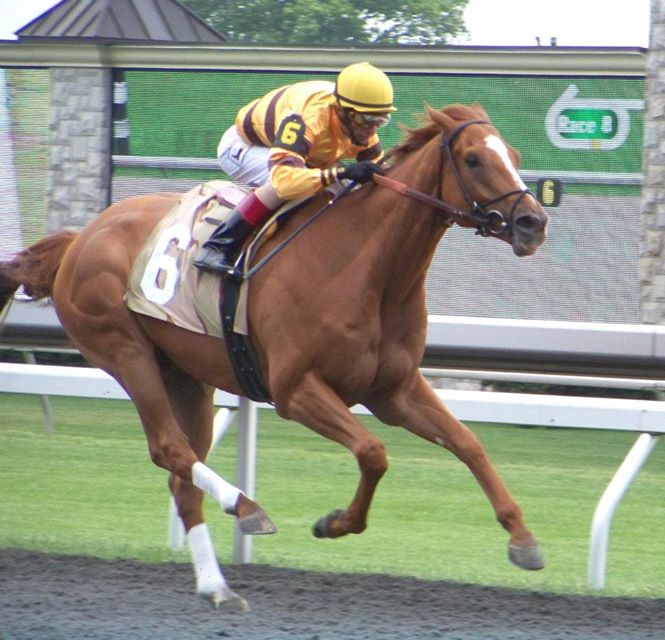 In 2006, Lisa Danielle foaled a colt by Successful Appeal, named Successful Dan, who has, so far, earned nearly $1,000,000, won four graded stakes, and set the track record for 1 1/16 miles at Churchill Downs in the 2012 Alysheba Stakes. If Successful Dan was Lisa Danielle’s only progeny, she would already be a successful broodmare. But Successful Dan is only her second most successful offspring. In 2006, Lisa Danielle foaled a colt by Successful Appeal, named Successful Dan, who has, so far, earned nearly $1,000,000, won four graded stakes, and set the track record for 1 1/16 miles at Churchill Downs in the 2012 Alysheba Stakes. If Successful Dan was Lisa Danielle’s only progeny, she would already be a successful broodmare. But Successful Dan is only her second most successful offspring.
In 2006, Lisa Danielle was bred to Wiseman’s Ferry for a stud fee of $1,000. The result, of course, was Wise Dan who has earned almost $6.5 million. Wise Dan has won 16 graded stakes, including two Breeders Cup Mile victories; and then there’s also the six Eclipse Awards: 2012 and 2013 Champion Turf Male, Champion Older Male, and Horse of the Year. Fink admits: “I’ve been in business for more than 40 years and it’s a major miracle when you breed and race a horse like Wise Dan.”
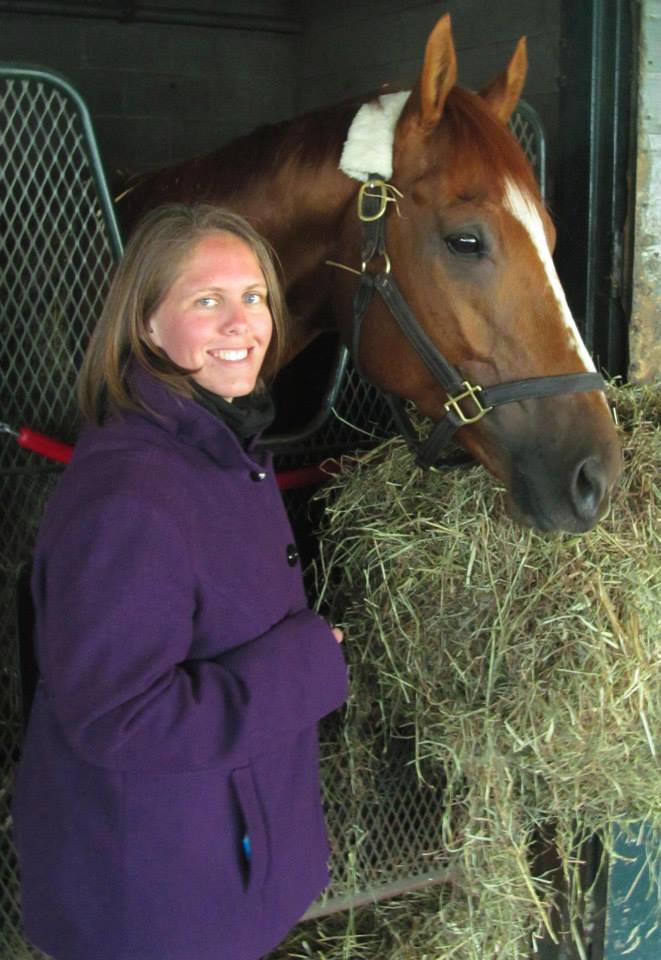 Morton Fink can’t hide his enthusiasm for Wise Dan: “It's hard to put in words, but you're in the business for forty years, and you know, you can do everything right and have the best of everything and then you get a bad trip and you lose. With this horse, this is crazy to say, it's almost impossible to do that to him. As soon as he sees daylight he's gone and nobody will beat him, nobody!” (Jockey World Contributing Writer, Kristen Neiding, pictured left with Wise Dan) Morton Fink can’t hide his enthusiasm for Wise Dan: “It's hard to put in words, but you're in the business for forty years, and you know, you can do everything right and have the best of everything and then you get a bad trip and you lose. With this horse, this is crazy to say, it's almost impossible to do that to him. As soon as he sees daylight he's gone and nobody will beat him, nobody!” (Jockey World Contributing Writer, Kristen Neiding, pictured left with Wise Dan)
After Wise Dan’s 2012 Breeders' Cup Mile victory, Morton Fink spoke of Lisa Danielle: “Whoever we bred her to, the horse comes out looking like her and they all run. She has had three stakes winners, five horses have won over $150,000 this is from a $29,000 mare and she gives people -- you have to be lucky. You can do things right but you have to be lucky, too.” Lisa Danielle was awarded as the 2012 Broodmare of the Year, and Morton Fink was named Small Breeder of the Year.
Morton Fink is proud of Wise Dan, and loves sharing him with the racing industry. Fink “couldn’t be happier that the horse is appreciated... he’s a special horse.” “He keeps me going. I said that before, and I meant it. You ask my family.” Racing truly is Morton Fink’s fountain of youth.
Photos with Wise Dan courtesy of Kristen Neiding and Ryan Brady

Jockey World Member Kristen Neiding started following horse racing after taking riding lessons during college at Miami University. She is now an attorney, focusing her practice in Equine Law. Every year during Kentucky Derby week, Kristen attends the National Conference on Equine Law in Lexington, Kentucky, hosted by the University of Kentucky. When not spending afternoons at her local racetrack, Thistledown, Kristen enjoys travelling to racetracks and horse farms in other states as far away as New York and Florida, or competing in local hunter jumper horse shows.
|
|
|
|
|
|
|
|
|
|
|
Ron Paolucci, Loooch Racing Stable, Inc.
March 22, 2014 by Kristen Neiding
 If you're wondering if there's a typo in the stable name, let me assure you, there's not. Loooch is actually the correct pronunciation of the third syllable of owner, Ron Paolucci's surname (pronounced "Pay-o-Loooch-ee"). If you're wondering if there's a typo in the stable name, let me assure you, there's not. Loooch is actually the correct pronunciation of the third syllable of owner, Ron Paolucci's surname (pronounced "Pay-o-Loooch-ee").
While Ron Paolucci may be best known for his Breeder's Cup winning filly, Ria Antonia, Loooch Racing actually consists of 50-60 horses at tracks across the country. Loooch Racing celebrated its second full year of existence in 2013, with 77 wins, which was 10th highest of all owners nationwide.
Ron Paolucci developed an interest in horse racing as a child, when he'd go to the racetrack with his grandfather. They would spend the day at Thistledown, then drive to Waterford Park (now Mountaineer), for evening races. Paolucci was eager to start wagering, and by 16, he was already skipping school to spend the day at Thistledown. Despite being a talented high school baseball player and being drafted by the Cincinnati Reds, horse racing took precedence. Paolucci skipped practice in 1988 to watch Personal Ensign storm past Winning Colors to cap her perfect career with a Breeder's Cup Distaff victory.
Though he loved horse racing, Ron Paolucci wasn't always a successful handicapper. Of the years he spent wagering more than he could afford to lose, Paolucci admits: "it's been a rough road; that's for sure." When he had children, Paolucci changed his attitude about handicapping, and became more responsible. "I just wanted a better lifestyle." Now, he approaches horse racing as a job, spending eight to twelve hours a day pouring over past performances, watching tapes of races, betting "from bell to bell," all the while taking notes on what he sees.
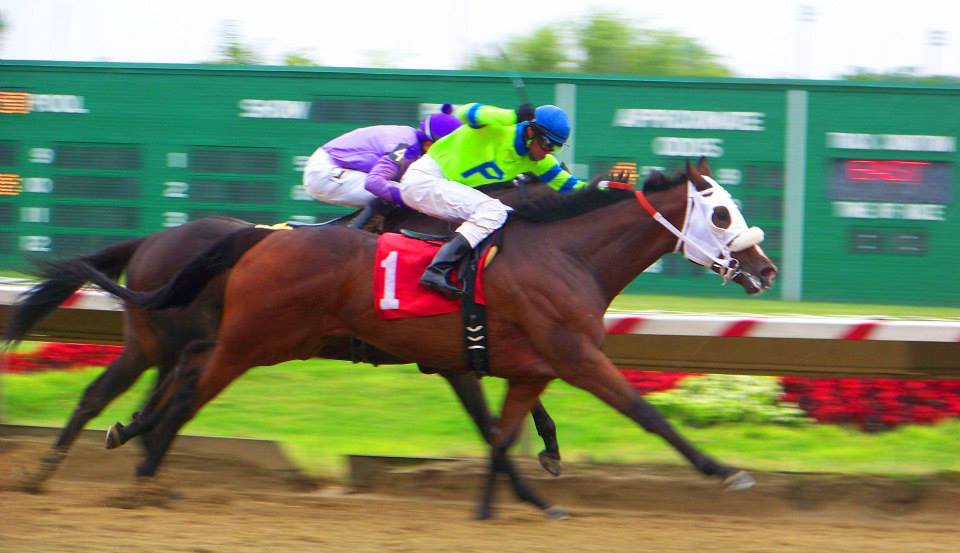 In 2011, Ron Paolucci claimed his first horse for $2,500. Now, when playing the races, Paolucci also keeps an eye out for new horses to claim. He loves looking for horses that are not "obvious," - horses other people may have missed. He says "The part that keeps me interested is picking my own horses… if I couldn't do that, I wouldn't be in the game." In 2011, Ron Paolucci claimed his first horse for $2,500. Now, when playing the races, Paolucci also keeps an eye out for new horses to claim. He loves looking for horses that are not "obvious," - horses other people may have missed. He says "The part that keeps me interested is picking my own horses… if I couldn't do that, I wouldn't be in the game."
Nowadays, he refers to himself as "a mid-level guy." Though he has a fairly large stable, with horses at tracks across the country, his stable consists mostly of claimers at small "minor league" tracks. While he acknowledges the difference in quality between tracks like Gulfstream Park and tracks like Thistledown, Paolucci recognizes the importance of both. While a Breeder's Cup race has more financial significance, an owner gets the same thrill from seeing his silks leading in the stretch of a claiming race. "A win is a win, it doesn't matter what level it is… It's contagious, it's addictive."
Paolucci acknowledges that he wouldn't have had the opportunity to buy Ria Antonia if it wasn't for his success in the lower levels of racing, and he is very appreciative of his trainers and jockeys. "One of the best trainers is in the Cleveland area, Jeff Radosevich. What he’s done with the horses is just amazing." Just last week, Paolucci noted that jockey Jake Radosevich has "been riding great… look forward to you coming up to Thistle and keeping it going."
.jpg) Paolucci has horses with different trainers at tracks across the country, and he'll move horses to a different track if the horse will have a better opportunity to win. It was exactly this type of race planning that earned Paolucci the biggest win of his short ownership career. When he purchased Ria Antonia, she had been racing on a synthetic surface at Woodbine. He planned to move Ria Antonia to dirt, add blinkers, and enter her in graded stakes. Though people thought he was crazy, Ron was vindicated when Ria Antonia flew down the stretch catching She's a Tiger with every stride. Regarding the photo finish, Paolucci said: “I was so ecstatic with the way she ran, it didn’t matter if she got up. I was right about her.” Paolucci has horses with different trainers at tracks across the country, and he'll move horses to a different track if the horse will have a better opportunity to win. It was exactly this type of race planning that earned Paolucci the biggest win of his short ownership career. When he purchased Ria Antonia, she had been racing on a synthetic surface at Woodbine. He planned to move Ria Antonia to dirt, add blinkers, and enter her in graded stakes. Though people thought he was crazy, Ron was vindicated when Ria Antonia flew down the stretch catching She's a Tiger with every stride. Regarding the photo finish, Paolucci said: “I was so ecstatic with the way she ran, it didn’t matter if she got up. I was right about her.”
Paolucci is planning for Ria Antonia to face colts in the future, and though people may call him crazy, he believes a Triple Crown race is the right spot for Ria Antonia. According to speed figures, the fillies are faster than the colts this year, meaning Ria Antonia may be facing easier competition by racing colts. Also, the colts' races will flatter Ria Antonia's running style. Paolucci believes that races for fillies go slower early and faster late, while colts go faster early and slower late. In other words, a race against colts will better suit the closing kick of the very tall, long-strided, Ria Antonia. Though Ria Antonia may not race in the Kentucky Derby, Paolucci said "Maybe I'll let [the colts] battle it out, then go to the Preakness."
Regarding the future, Paolucci plans to expand his stable and move from the top 10 owners by wins to the top 5. Also, since he sees incentives in the Ohio breeding program, Paolucci already has some mares on a farm waiting to be bred to his 6 year old, multiple stakes winner, Global Power.
Call him crazy if you will, but Ron Paolucci has made a big impact in racing, and 2014 is only his third full year of ownership. Once Paolucci starts breeding, we may see as many successful Global Power babies as we see successful Ramsey Kittens!
Photos courtesy of Kristen Neiding, Thistledown Racetrack, 2013

Jockey World Member Kristen Neiding started following horse racing after taking riding lessons during college at Miami University. She is now an attorney, focusing her practice in Equine Law. Every year during Kentucky Derby week, Kristen attends the National Conference on Equine Law in Lexington, Kentucky, hosted by the University of Kentucky. When not spending afternoons at her local racetrack, Thistledown, Kristen enjoys travelling to racetracks and horse farms in other states as far away as New York and Florida, or competing in local hunter jumper horse shows.
|
|
|
|
|
|
|
|
|
|
|
"Jim Rome’s Jungle Racing, LLC"
February 23, 2014 by Kristen Neiding
 For most owners, when your star racehorse comes to the end of her racing career, you expect to have a bit of a lull in your stable. Not so, for Jim Rome’s Jungle Racing, LLC. For most owners, when your star racehorse comes to the end of her racing career, you expect to have a bit of a lull in your stable. Not so, for Jim Rome’s Jungle Racing, LLC.
Mizdirection ran her final race in the Breeders’ Cup Turf Sprint on November 2, 2013. Two days later, she entered the Fasig Tipton auction ring in Lexington, Kentucky, and was sold for $2.7 million. The following weekend, two year old gelding, Shared Belief, made his first start for Jim Rome as he was hand ridden to a 7 3/4 length victory in the Grade III Hollywood Prevue Stakes.
Yet Jungle Racing, LLC nearly did not exist. Although Jim Rome grew up with horses living on his property, he had no interest in them. When he became a national sports media personality, he voiced the opinion that horse racing is a bet, not a sport. Looking back, Rome says, "It made no sense to me whatsoever. I never got it." Rome acknowledges that he has made a complete 180 in terms of his view on horse racing. “I’d never spent time around the barns or the animal or the jockeys or the trainers; then I started to come around and I got to know the horses. At the end of the day, the biggest reason we’re in this is we love the horses. It didn’t matter if it was a stakes horse or Breeders’ Cup or a claimer. They’re all different, they all have a different story, and I think they’re fascinating animals.” He now describes himself as a "lifer"; a proponent of horse racing.
His love for horse racing began in 2007, when his wife, Janet, encouraged him to buy into a racehorse, for a reason none other than “it will be fun.” The horse was Wing Forward, who was making his first start in the U.S. in an allowance race at the Oak Tree meet at Santa Anita. He was sent off at odds of 14-1, and he “came out of the clouds to win from last to first.” The thrill of that single race had Jim Rome hooked on the sport.
The following years were not easy. Rome describes the experience as: "burning through a pile of cash and getting my brains beaten in." Despite the difficulties, Rome stuck with it because he enjoyed the horses. Rome's love for the horses is apparent on his Jungle Racing Facebook page: www.facebook.com/JungleRacing
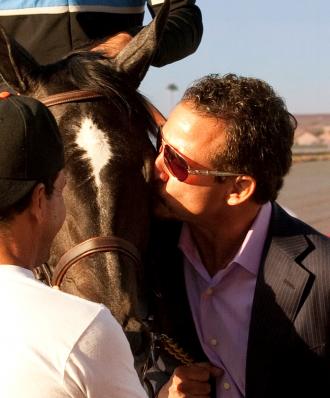 Jim Rome has overwhelming respect for Mizdirection: "I've never been around an athlete quite like that. She's so proud, and so mean, and so competitive. I'm actually awed by the horse. She's my favorite athlete ever." Despite calling Mizdirection "one of the loves of my life," Jim Rome made the difficult decision to enter her in the Fasig Tipton sale. He explained: “One of the only things I don’t like about this business is that it’s a business. The Miz ride has been one of the great experiences of my life. But the fact is before Mizdirection, I always had a great passion for the sport, but we got our brains beaten in and we lost a lot of money." Jim Rome has overwhelming respect for Mizdirection: "I've never been around an athlete quite like that. She's so proud, and so mean, and so competitive. I'm actually awed by the horse. She's my favorite athlete ever." Despite calling Mizdirection "one of the loves of my life," Jim Rome made the difficult decision to enter her in the Fasig Tipton sale. He explained: “One of the only things I don’t like about this business is that it’s a business. The Miz ride has been one of the great experiences of my life. But the fact is before Mizdirection, I always had a great passion for the sport, but we got our brains beaten in and we lost a lot of money."
The $2.7 million from Mizdirection's sale gives Rome the funds to purchase more horses; horses like Shared Belief, who Jim Rome bought in partnership after the gelding won his first start by 7 lengths at Golden Gate Fields. Jim Rome says that he had no specific goals when he got involved in horse racing. “I just fell in love with the horses and the game… I realized the Derby was probably just a dream. An impossible dream. And it still feels that way."
Reminiscing about Mizdirection's first Breeders Cup, Rome says: "Just being in the gate for that race is one of the highlights of my life… It really was the most spectacular and surreal day of my life." After the second Breeders Cup victory, he reiterated that feeling, and added: "Today might be better. It is that good." After ranking the Breeders Cup victories among the best days of his life, it's easy to appreciate how meaningful it would be for Rome to find Shared Belief in a Churchill Downs starting gate on the first Saturday in May.

Jockey World Member Kristen Neiding started following horse racing after taking riding lessons during college at Miami University. She is now an attorney, focusing her practice in Equine Law. Every year during Kentucky Derby week, Kristen attends the National Conference on Equine Law in Lexington, Kentucky, hosted by the University of Kentucky. When not spending afternoons at her local racetrack, Thistledown, Kristen enjoys travelling to racetracks and horse farms in other states as far away as New York and Florida, or competing in local hunter jumper horse shows.
|
|
|
|
|
|
|
|
|
|
|
"It's Time"
May 18, 2013 by Kathryn Lindquist
Follow up to last month's article featuring Kentucky Derby-winning owner Phipps...
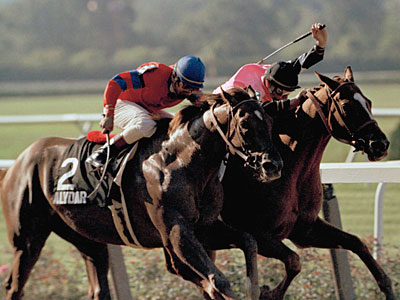 We have all waited long enough. Year after year, spring after spring, hope springs eternal in Kentucky, is sometimes carried through to Baltimore and is often crushed on the grand New York stage. But this year feels different. Is it quite possible that we will see our first Triple Crown winner since 1978? We have all waited long enough. Year after year, spring after spring, hope springs eternal in Kentucky, is sometimes carried through to Baltimore and is often crushed on the grand New York stage. But this year feels different. Is it quite possible that we will see our first Triple Crown winner since 1978?
Many of racing's biggest stars have lived and breathed a career untouched by a Triple Crown winner. Superstar jockey Rosie Napravnik, recently featured on "60 Minutes," was not born until 10 years after Affirmed dueled with Alydar down the long Belmont stretch. The last time a horse won the Triple Crown Jimmy Carter was President, the first cellular phone debuted and a dozen eggs only cost 48 cents.
Kentucky Derby winner Orb may have a jockey atop his withers that has never seen a horse capture the Triple Crown. But the men who own and train Orb, certainly have. The Phipps Family and class act Shug McGuaghey have all dared to chase what may be the greatest prize in all of sports.
 Racing has been deprived of a Triple Crown champion for many years. But yes, this may very well be the year. Racing has been deprived of a Triple Crown champion for many years. But yes, this may very well be the year.
If Orb can outrun the trouble of an inside post in Saturday's Preakness Stakes (NBC 4:30 pm EST) many are confident that only the racing gods can withhold him from victory on June 8 at Belmont Park.
Belmont has been the graveyard for Triple Crown attempts in the last three decades. Whether it be the deep surface which lends the affectionate nickname "Big Sandy" to the track, or the classic mile and a half distance; misplaced safety pins, injuries, or bad breaks - Belmont has claimed its fair share of victors attempting to become legends.
 But this year feels different. Orb loves Belmont's deep track and trains over it frequently. His pedigree shouts distance and prowess. Orb is fast, simply and utterly fast, with a damaging turn of foot. And he's gutsy too. But this year feels different. Orb loves Belmont's deep track and trains over it frequently. His pedigree shouts distance and prowess. Orb is fast, simply and utterly fast, with a damaging turn of foot. And he's gutsy too.
It's been 40 years since Secretariat gave America its first Triple Crown winner in a quarter of a century. If Orb can carve a path alongside that trail to glory, he will give the country it's first racing legend in 35 years. A drought gone too far. It's time for racing's newest generation to find their Big Red, their Affirmed, Seattle Slew, Citation or War Admiral. It's time for the nation to see that three sided silver trophy hoisted high in the summer wind. Eleven names engraved on the surface, beckoning "Orb" to join their exclusive pantheon.

Jockey World Member Kathryn Lindquist has been a racing fan for many years. She first became involved in the sport as a press member at the Colonial Cup Steeplechase in 2007 when she photographed the final race of her favorite racehorse - three time Eclipse Award champion McDynamo. She is currently pursuing a career in international relations and is an avid distance runner.
|
|
|
|
|
|
|
|
|
|
|
"Ogden Phipps"
April 16, 2013 by Kathryn Lindquist
 Black silks with a red cap: simple yet iconic in every manner. These are the racing colors of Ogden Mills “Dinny” Phipps who was born in 1940 in New York City and has since created one of the most prominent and successful Thoroughbred racing stables in America. Black silks with a red cap: simple yet iconic in every manner. These are the racing colors of Ogden Mills “Dinny” Phipps who was born in 1940 in New York City and has since created one of the most prominent and successful Thoroughbred racing stables in America.
The stables' roots lie in Wheatley Stable, which was started in 1926 by Phipps’ grandmother, Mrs. Henry Carnegie Phipps. Mrs. Phipps directed Wheatley Stable until her death in 1970, when it transferred hands to Ogden. As he was approaching his 80's, Ogden wanted to ensure that his family would continue in the racing tradition that had been in his family for so long. So now, the stable is owned in combination by Ogden and his children.
Ogden is a member of the Board of Directors and a past chairman of the Jockey Club and New York Racing Association. He is also a member of the Jockey Club of Canada and serves on the board of the Breeders’ Cup Limited and the National Thoroughbred Racing Association.
In 1978, Ogden received the Eclipse Award of Merit, the horse racing industry’s most prestigious award, and was voted the New York Turf Writers Award as “The Man Who Did The Most For Horse Racing.” In 2002, Ogden received the Industry Service Award from the Thoroughbred Owners and Breeders Association.
 Some of the greatest horses of this century have carried Ogden’s famed silks to victory. Rhythm won the 1989 Breeders’ Cup Juvenile and was named the champion two-year-old colt of that year. Dispute was a winner of four Grade 1 events including the Kentucky Oaks. Inside Information captured the 1995 Breeders’ Cup Distaff in one of America’s most exciting finishes, was named that year’s champion older female and was inducted into the U.S. Racing Hall of Fame in 2008. Storm Flag Flying won the 2002 Breeders’ Cup Juvenile Fillies and was named that year’s champion two-year-old filly. Some of the greatest horses of this century have carried Ogden’s famed silks to victory. Rhythm won the 1989 Breeders’ Cup Juvenile and was named the champion two-year-old colt of that year. Dispute was a winner of four Grade 1 events including the Kentucky Oaks. Inside Information captured the 1995 Breeders’ Cup Distaff in one of America’s most exciting finishes, was named that year’s champion older female and was inducted into the U.S. Racing Hall of Fame in 2008. Storm Flag Flying won the 2002 Breeders’ Cup Juvenile Fillies and was named that year’s champion two-year-old filly.
Current runners of Phipps Stables include Point of Entry, who has blossomed into one of America’s leading grass runners, and Orb who recently won the Florida Derby (G.1) and is a leading Kentucky Derby contender. And perhaps, come the first Saturday in May, Ogden will see his silks in the Winner’s Circle at Churchill Downs atop that colt.

Jockey World Member Kathryn Lindquist has been a racing fan for many years. She first became involved in the sport as a press member at the Colonial Cup Steeplechase in 2007 when she photographed the final race of her favorite racehorse - three time Eclipse Award champion McDynamo. She is currently pursuing a career in international relations and is an avid distance runner.
|
|
|
|
|
|
|
|
|
|
"Sheikh Mohammed"
March 14, 2013 by Kathryn Lindquist
 Horse racing has always been called the "Sport of Kings" and some ownership operations today still live up to the title. In fact, one of the premier Thoroughbred racing and breeding operations is owned by a man of great royalty, HH Sheikh Mohammed bin Rashid Al Maktoum. As the ruler of Dubai and vice-president of the United Arab Emirates, he has much already on his plate but always makes room in his routine to tend to his racehorses. Horse racing has always been called the "Sport of Kings" and some ownership operations today still live up to the title. In fact, one of the premier Thoroughbred racing and breeding operations is owned by a man of great royalty, HH Sheikh Mohammed bin Rashid Al Maktoum. As the ruler of Dubai and vice-president of the United Arab Emirates, he has much already on his plate but always makes room in his routine to tend to his racehorses.
He races his champions under the royal blue silks of his Darley Stud and Godolphin Stables, which have a foothold in nations spanning the globe. From Australia, France, Ireland, Japan, the United Kingdom and Dubai, to the United States, his horses have won some of the most prestigious and recognizable events in the sport.
Darley was founded in 1981 when Sheikh Mohammed purchased the Dalham Hall Stud in Newmarket, Suffolk, England. And since then, has made it one of the top stud farms whose line of greatness started with a colt named Dubai Millennium who was born at Dalham and trained at Newmarket. Dubai Millennium went on to destroy his competitors in the Dubai World Cup and Prince of Wales's Stakes at Royal Ascot in 2000.
From England, Sheikh Mohammed's venture expanded. In the United States he based his operations at Jonabell Farm in Lexington, Kentucky and in Ireland at the Kildangan Stud, County Kildare.
 Sheikh Mohammed is a three-time winner of the Eclipse Award as outstanding owner in 2009 with Godolphin and in 2006 and 2012 with Darley Stables. He also received a special Eclipse Award in 2001 for his contribution to racing and society following the attacks on 9/11. Sheikh Mohammed was in attendance at the Keeneland sales when the attacks occurred. Right away, he made a $5 million personal contribution to the disaster relief fund organized by Keeneland and pledged 100% of his Breeders' Cup World Thoroughbred Championship day earnings to the NTRA Charities-New York Heroes Fund. Sheikh Mohammed is a three-time winner of the Eclipse Award as outstanding owner in 2009 with Godolphin and in 2006 and 2012 with Darley Stables. He also received a special Eclipse Award in 2001 for his contribution to racing and society following the attacks on 9/11. Sheikh Mohammed was in attendance at the Keeneland sales when the attacks occurred. Right away, he made a $5 million personal contribution to the disaster relief fund organized by Keeneland and pledged 100% of his Breeders' Cup World Thoroughbred Championship day earnings to the NTRA Charities-New York Heroes Fund.
Although he has not yet succeeded in capturing the elusive Kentucky Derby, Sheikh Mohammed has campaigned some very special horses including Midshipman (2008, champion 2-year-old male), Tempera (2001, champion 2-year-old female), Fantastic Light (2001, champion turf male), Pebbles (1995, champion turf female) and Preakness Stakes victor Bernardini (2006, champion 3-year-old male).
He continues to look for the horse that will take him to the winners' circle on the first Saturday in May.

Jockey World Member Kathryn Lindquist has been a racing fan for many years. She first became involved in the sport as a press member at the Colonial Cup Steeplechase in 2007 when she photographed the final race of her favorite racehorse - three time Eclipse Award champion McDynamo. She is currently pursuing a career in international relations and is an avid distance runner.
|
|
|
|
|
|
|
|
|
|
"Stonestreet Farm"
February 18, 2013 by Kathryn Lindquist
 One may ask what fine wine and great racehorses have in common; and the answer would be the late Jess Jackson. One may ask what fine wine and great racehorses have in common; and the answer would be the late Jess Jackson.
Known for his world renowned wine brand, Kendall-Jacoson Winery, Jackson turned his life-long affection and respect for the Thoroughbred into a business in 2003 when he acquired several horses in auction. Two years later he purchased Buckram Oak Far in sprawling Lexington, Kentucky and established his own Stonestreet Farm.
He designed his silks of gold and burgundy, representing his home state of California's gold rush and mountains, and the purple hue of wine, respectively. Along with his wife, Barbara Banke, a team of expert trainers, grooms and staff, Jackson and Stonestreet hit the ground running and appeared to bear successful from the very beginning. While success generally takes decades to be mined in the racing business, less than five years after his initial acquisitions, Jackson set the racing news on fire when the mighty Curling hit the track. The two time Horse-of-the-Year is called by some the greatest horse of this decade and perhaps one of the greatest racehorses of all time.
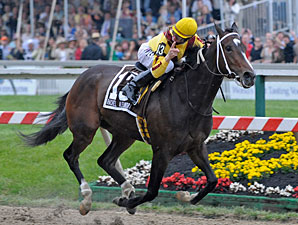 But, despite Curlin's sheer dominance, it was a lanky, dainty looking filly named Rachel Alexandra that carried Stonestreet Farm into the history books and also the public's eye. She is widely known for defeating her male counterparts in the 2009 Preakness Stakes and Haskell Invitational and against older horses in the Woodward Stakes at Saratoga. She was named 2009 Horse-of-the-Year for her monumental efforts, making it three years in a row for Jackson following Culin's back-to-back wins. But, despite Curlin's sheer dominance, it was a lanky, dainty looking filly named Rachel Alexandra that carried Stonestreet Farm into the history books and also the public's eye. She is widely known for defeating her male counterparts in the 2009 Preakness Stakes and Haskell Invitational and against older horses in the Woodward Stakes at Saratoga. She was named 2009 Horse-of-the-Year for her monumental efforts, making it three years in a row for Jackson following Culin's back-to-back wins.
Although retired in September 2011, Rachel Alexandra still captures the nation's attention today, as she did on the racetrack. In an effort to create a "Super Horse," Jackson made the decision to breed his two champions, Curlin and Rachel Alexandra, as a breeding between two Horse-of-the-Year winners is extremely rare.
 On April 21, 2011 after a long battle with cancer, Jackson passed away at age 81. Just less than a year after his passing, Rachel Alexandra foaled a large bay colt by Curlin. The colt was aptly named Jess's Dream after their late owner. On April 21, 2011 after a long battle with cancer, Jackson passed away at age 81. Just less than a year after his passing, Rachel Alexandra foaled a large bay colt by Curlin. The colt was aptly named Jess's Dream after their late owner.
And on February 12, 2013, Rachel Alexandra foaled a very large filly by the champion Bernardini. This time, unfortunately, things went a different path, an uncharted course, a dangerous turn for the worse. The champion filly is in critical condition. The foal is placed on a nurse mare, thrust into life in the harshest of ways. The racing world hangs in the balance. And Barbara Banke is working with vets from around the country - doing their best to keep Jackson's dream alive.

Jockey World Member Kathryn Lindquist has been a racing fan for many years. She first became involved in the sport as a press member at the Colonial Cup Steeplechase in 2007 when she photographed the final race of her favorite racehorse - three time Eclipse Award champion McDynamo. She is currently pursuing a career in international relations and is an avid distance runner.
|
|
|
|
|
|
|
|
|
|
|
"Team Valor International"
January 14, 2013 by Kathryn Lindquist
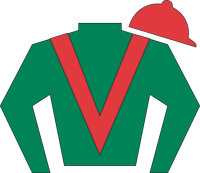 Animal Kingdom, the 2011 Kentucky Derby winner, is back to the races and looking just as good as he did when he wore the roses. This brings owner Barry Irwin and stable Team Valor International back into the national racing spotlight. Animal Kingdom, the 2011 Kentucky Derby winner, is back to the races and looking just as good as he did when he wore the roses. This brings owner Barry Irwin and stable Team Valor International back into the national racing spotlight.
Headquartered in Versailles, Kentucky, Team Valor International was originally founded in 1988, when the then called Clover Racing Stable was created by Irwin and Jeff Siegel.
In 1997, Irwin became the operation's sole owner when he bought out Siegel and took over the reins of Clover Racing Stable. But not long after this change, he began thinking of bigger and better things. He renamed the stable to Team Valor International and began thinking of racing as a worldwide game.
Irwin began encouraging partnerships within the racing business, as well as in its fan base in hopes of attracting new blood to the sport. Today, the stable has partnerships in the United States, Japan, Singapore, Canada, South Africa, Italy and England.
Nearly 30 percent of all Team Valor International's runners have been stakes winners, while half have competed at that level. And with this success, the dream of winning the most famous horse race in the world soon follows. Dreams of red roses, a gold cup, and a potential trip to New York with a chance at winning the Triple Crown.
 In 2011, it was a large, fiery chestnut named Animal Kingdom that brought Irwin and his partners the red roses. When his colt ran away in the Kentucky Derby with a decisive victory, thoughts of another Triple Crown winner soon arose. But it was not meant to be and Animal Kingdom fell to the might of the middle distance specialist Shackleford in the Preakness Stakes. Then once again, after a troubling start, literally fell again in the Belmont. In 2011, it was a large, fiery chestnut named Animal Kingdom that brought Irwin and his partners the red roses. When his colt ran away in the Kentucky Derby with a decisive victory, thoughts of another Triple Crown winner soon arose. But it was not meant to be and Animal Kingdom fell to the might of the middle distance specialist Shackleford in the Preakness Stakes. Then once again, after a troubling start, literally fell again in the Belmont.
But now Animal Kingdom is back after displaying brilliant talent in the 2012 Breeders' Cup Mile and so is Irwin and all of Team Valor International. While many Derby winning racehorses are retired following their three year old campaign, Animal Kingdom is still racing at 5 years old. Irwin believes in his colt and so does America. He created the partnership idea within Team Valor International to keep people close to racing and Animal Kingdom's career is a living testimony to that desire.

Jockey World Member Kathryn Lindquist has been a racing fan for many years. She first became involved in the sport as a press member at the Colonial Cup Steeplechase in 2007 when she photographed the final race of her favorite racehorse - three time Eclipse Award champion McDynamo. She is currently pursuing a career in international relations and is an avid distance runner.
|
|
|
|
|
|
|
|
|
|
|
"Dogwood Stables"
November 29, 2012 by Kathryn Lindquist

Removed from farms decked with grandeur in Kentucky, the rugged warmth of California ranches and the sprawling expanses of land in Ocala, is the beautiful Dogwood Stables of Aiken, South Carolina.
South Carolina was once the mecca of training centers and winter residencies of some of racing's biggest stars. But as time went on and the racing business changed, many stables moved out of the state to expand in Kentucky, where racing is more prevalent; Dogwood Stables however, remained and bloomed.
Its iconic green silks marked with distinct yellow circles have been carried to victory by seventy-seven stakes winners, six Kentucky Derby starters, six millionaires, two Eclipse Award winners, and the winners of one Breeders' Cup race and one Preakness Stakes. These are credentials that even some of racing's most established stables cannot stake claim to.
Dogwood Stables is one of the initial racing partnerships in the business, which now are common. The idea was the brainchild of President W. Cothran "Cot" Campbell. The idea to give people the opportunity to participate in racing without spending millions of dollars appealed to him, and that led to bountiful success.
The 1990 Preakness Stakes winner Summer Squall, Eclipse Award winner Storm Song, Eclipse Award winning steeplechase horse Inlander and stakes winners Limehouse, Trippi, Cotton Blossom, and Aikenite were all raced by Dogwood partnerships.
Their success also impacted the career of Jockey World founder Frankie Lovato, Jr, who 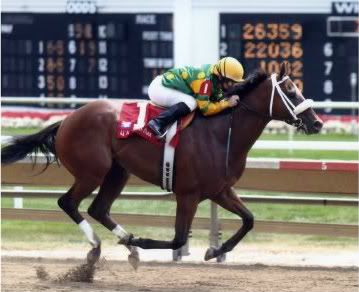 rode many winners bearing the Dogwood silks during his 25 year career. In fact, the recognizable Jockey World web banner and Lovato's "What It Takes To Be A Jockey" DVD cover depict him wearing the famous Dogwood colors. Campbell and Dogwood Stables have supported Frankie from the beginning and now support Jockey World and its' mission. rode many winners bearing the Dogwood silks during his 25 year career. In fact, the recognizable Jockey World web banner and Lovato's "What It Takes To Be A Jockey" DVD cover depict him wearing the famous Dogwood colors. Campbell and Dogwood Stables have supported Frankie from the beginning and now support Jockey World and its' mission.
The highly successful racehorses raced by Dogwood Stables are different than many other champions in the industry. They are not owned by rulers from Dubai or millionaire oil tycoons. Instead they are owned by regular everyday working men and women who form a team and guide horse after horse into the winners' circles on some of racing's biggest stages. They have proven that success can be forged in even the most unlikely places, even on a farm nestled in South Carolina.

Jockey World Member Kathryn Lindquist has been a racing fan for many years. She first became involved in the sport as a press member at the Colonial Cup Steeplechase in 2007 when she photographed the final race of her favorite racehorse - three time Eclipse Award champion McDynamo. She is currently pursuing a career in international relations and is an avid distance runner.
|
|
|
|
|
|
|
|
|
|
|
"Kenneth and Sarah Ramsey"
October 15, 2012 by Kathryn Lindquist
 Almahurst Farm, which saw the birth of 1918 Kentucky Derby winner Exterminator and Standardbred champion Greyhound, was purchased by Kenneth and Sarah Ramsey in 1994. They renamed it Ramsey Farm. Almahurst Farm, which saw the birth of 1918 Kentucky Derby winner Exterminator and Standardbred champion Greyhound, was purchased by Kenneth and Sarah Ramsey in 1994. They renamed it Ramsey Farm.
It was a horse named Red Redeemer that lit their interest in the sport in 1969. He claimed the horse for $1,500 at Miles Park in Louisville. Red Redeemer was blind in one eye and never won again. Since then, they have found better luck.
In 2004 Ken and Sarah Ramsey received the Eclipse Award for outstanding owners, partially thanks to their champion turf male homebred, Kitten's Joy. They then raced Grade 1 winner Roses in May, who went on to win the 2005 Dubai World Cup and propelled the Ramseys to the leading owners list that year. 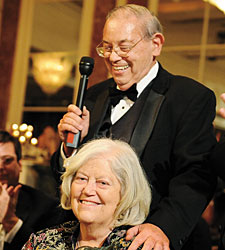
The Ramseys have not only found the Winner's Circle on major Thoroughbred racing tracks such as Keeneland and Churchill Downs, where they earned 12 leading owner titles. But in 2010, their striking grey colt Slip Away was named champion steeplechase horse at the Eclipse Awards.
Called one of the most talented steeplechase horse in the last few years, Slip Away captured the Colonial Cup Steeplechase (NSA-1) in 2010 with Secretariat-like speed, blowing the field away with a 25 3/4 length victory.
Ken and Sarah Ramsey have dedicated their lives to horse racing, running their horses on major tracks around the world and smaller steeplechase courses scattered up and down the east coast. And it's all for the love of the horse.

Jockey World Member Kathryn Lindquist has been a racing fan for many years. She first became involved in the sport as a press member at the Colonial Cup Steeplechase in 2007 when she photographed the final race of her favorite racehorse - three time Eclipse Award champion McDynamo. She is currently pursuing a career in international relations and is an avid distance runner.
|
|
|
|
|
|
|
|
|
|
|
"Reeves Thoroughbred Racing"
September 15, 2012 by Kathryn Lindquist
 Foolish Pleasure’s 1975 Kentucky Derby triumph was the first Run for the Roses that Dean Reeves ever attended. Now, two decades later, Reeves has attended every Derby since then and has become a successful horse owner in the process. Foolish Pleasure’s 1975 Kentucky Derby triumph was the first Run for the Roses that Dean Reeves ever attended. Now, two decades later, Reeves has attended every Derby since then and has become a successful horse owner in the process.
Racing alongside classic racing stables with the names of Caliborne and Phipps – Dean and his wife Patti are newcomers to the sport, buying their first racehorse in 2007. They were inspired to take a leap of faith and dole out money for a horse after meeting Bob and Esther Ades, who had their first Kentucky Derby starter in 1992, in the Turks and Caicos Islands while on vacation.
Their immediate goal was to have a horse run in the Kentucky Derby – the race Dean had so closely paid attention to over the years. And just four years after their first purchase, the horse that would take them to Churchill Downs arrived. His name was Mucho Macho Man and he is currently ranked as one of the top horses in the nation.
 Mucho Macho Man would not win the Run for the Roses. But he fought hard and finished a closing third. But he gave the Reeves family what they had sought to do – have a horse parade on the track with “My Old Kentucky Home” soaring over the red track. Mucho Macho Man would not win the Run for the Roses. But he fought hard and finished a closing third. But he gave the Reeves family what they had sought to do – have a horse parade on the track with “My Old Kentucky Home” soaring over the red track.
After tired 6th and 7th place finishes in the 2011 Preakness and Belmont Stakes, respectively, Mucho Macho Man aimed to rebound in 2012. And that he did. In January, he scored smartly in an Allowance Race, and then followed that victory up with wins in the Sunshine Millions Classic and Gulfstream Park Handicap (G2). Perhaps his biggest victory of the year was the Suburban Handicap at Belmont Park in June.
Now, after a good effort in the Woodward Stakes (G1), finishing second to stakes winner To Honor And Serve, Mucho Macho Man is being aimed for a run in the Breeders’ Cup Classic and a shot to win the richest race in America.

Jockey World Member Kathryn Lindquist has been a racing fan for many years. She first became involved in the sport as a press member at the Colonial Cup Steeplechase in 2007 when she photographed the final race of her favorite racehorse - three time Eclipse Award champion McDynamo. She is currently pursuing a career in international relations and is an avid distance runner.
|
|
|
|
|
|
|
|
|
|
|
"Zayat Stables"
August 14, 2012 by Kathryn Lindquist
 Even as a teen, Ahmed Zayat had a love for horses. In his native Egypt, he competed in show jumping events and was introduced to race horses through the sport. Ever since, he has had a burning desire to become a driving force in the racing industry. Even as a teen, Ahmed Zayat had a love for horses. In his native Egypt, he competed in show jumping events and was introduced to race horses through the sport. Ever since, he has had a burning desire to become a driving force in the racing industry.
At first, it may have seemed that Zayat was diverging from his dream. He was a successful entrepreneur in charge of Al Ahram Beverages, which he later sold to Heineken International for some $280 million. But in reality, his business ventures were what gave him the chance to pursue his dream.
That dream, however, was never easy to come by for Zayat both on the track and in the board room. In 2010, he had his Derby horse: the talented and bold Eskendereya who had run away with the Wood Memorial (G1) and was the heavy favorite for the Run for the Roses. But the colt was scratched from the race just days before and never ran again.
Zayat filed for Chapter 11 bankruptcy and appeared to be going under. Instead, however, he gallantly continued his march to greatness and things began to turn around for him.
 His silks were carried by graded stakes winners Jaycito, AZ Warrior, Rightly So, and Riley Tucker. His highly touted colt Pioneer of the Nile finished second in the Kentucky Derby. In 2012, his horses finished second in each leg of the Triple Crown. Bodemeister placed in the Derby and Preakness Stakes, and Paynter, future Haskell Invitational victor, was caught at the wire by Union Rags in the Belmont. His silks were carried by graded stakes winners Jaycito, AZ Warrior, Rightly So, and Riley Tucker. His highly touted colt Pioneer of the Nile finished second in the Kentucky Derby. In 2012, his horses finished second in each leg of the Triple Crown. Bodemeister placed in the Derby and Preakness Stakes, and Paynter, future Haskell Invitational victor, was caught at the wire by Union Rags in the Belmont.
Perhaps it is a sign of what is to come for Zayat. He currently owns 200 horses, and his operation continues to grow. With both Paynter and Bodemeister among the most talented horses in training right now, Zayat looks to have a strong contingent heading into the 2012 Breeders' Cup come November and a chance to make history.

Jockey World Member Kathryn Lindquist has been a racing fan for many years. She first became involved in the sport as a press member at the Colonial Cup Steeplechase in 2007 when she photographed the final race of her favorite racehorse - three time Eclipse Award champion McDynamo. She is currently pursuing a career in international relations and is an avid distance runner.
|
|
|
|
|
|
|
|
|
|
|
"Starlight Racing"
July 16, 2012 by Kathryn Lindquist
.jpg) The banner atop Starlight Stables’ website proclaims “reach for the stars” and that is exactly what this world class racing team has been doing in recent years. Their list of accomplishments is far reaching, with their primary goal being to not only race at the highest echelon of the sport, but to also win at that level. The banner atop Starlight Stables’ website proclaims “reach for the stars” and that is exactly what this world class racing team has been doing in recent years. Their list of accomplishments is far reaching, with their primary goal being to not only race at the highest echelon of the sport, but to also win at that level.
Longtime racing fans Jack and Laurie Wolf founded Starlight Stables in 2000 and are connected with ownership partners Donald and Barbara Lucarelli. The stable has some of the most successful and well known horse racing professionals involved with their operation. Retired jockey and on-track reporter Donna Barton Brothers serves as Chief Operating Officer, multiple Eclipse Award winner Todd Pletcher trains their string of horses, bloodstock agent Frank Brothers identifies racing prospects, and Jake “J.J” Pletcher, Todd Pletcher’s father, trains and breaks future stars.
Starlight Stables has campaigned some of the most talented horses in recent racing history including 2004 champion three-year-old filly and 2005 champion older mare Ashado, three time Grade 1 winner Harlan’s Holiday, two time Grade 1 winner Octave.
The stable has earned purses totaling near $17 million and boats an approximate 21% win percentage and a nearly 50% in the money percentage.
 One of their current stars in three-year-old colt Algorithms, a half-brother to graded stakes winner Keyed Entry. Algorithms defeated Eclipse Award winning Two-Year-Old Champion Hansen in the Grade 3 Holy Bull Stakes and earned a 105 Beyer Speed figure in that victory, placing him among the fastest of his generation. One of their current stars in three-year-old colt Algorithms, a half-brother to graded stakes winner Keyed Entry. Algorithms defeated Eclipse Award winning Two-Year-Old Champion Hansen in the Grade 3 Holy Bull Stakes and earned a 105 Beyer Speed figure in that victory, placing him among the fastest of his generation.
Starlight Racing not only has had a profound impact on the racing world, but is also set to impact the future of horse racing as they have generously sponsored a student to attend Jockey Camp in Norwalk, Ohio from July 27 – 29 so that student can “reach for the stars” and their racing dreams.

Jockey World Member Kathryn Lindquist has been a racing fan for many years. She first became involved in the sport as a press member at the Colonial Cup Steeplechase in 2007 when she photographed the final race of her favorite racehorse - three time Eclipse Award champion McDynamo. She is currently pursuing a career in international relations and is an avid distance runner.
|
|
|
|
|
|
|
|
|
|
|
"Juddmonte Farms"
June 25, 2012 by Kathryn Lindquist
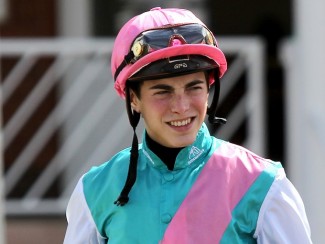 In recent years, few racehorses have distinguished themselves enough to not only clear the bars of challenge set before them, but have their performances used as a yardstick of comparison for others. Number one ranked colt Frankel, however, has done both, in part because of the dedicated hands of Juddmonte Farms that are guiding his racing career. In recent years, few racehorses have distinguished themselves enough to not only clear the bars of challenge set before them, but have their performances used as a yardstick of comparison for others. Number one ranked colt Frankel, however, has done both, in part because of the dedicated hands of Juddmonte Farms that are guiding his racing career.
Juddmonte is one of the most famous and successful racing operations in the world. Owned by Prince Khalid Adbullah of Saudi Arabia, Juddmonte has found success on racetracks in almonst every major country in the world. And it appears as though their spectacular Frankel, named for the late Bobby Frankel, who dedicated much of his life to training Juddmonte's best horses, is their crowning achievement.
Prince Abdullah's Juddmonte Farms consists of eight individual farms, three of which are found in the United States and England, and two in Ireland. For decades, Juddmonte has been bestowed a variety of awards for its racing and breeding excellence. To date, these include 10 Eclipse Awards, winning Top Breeder in 1995, 2001, 2002, 2003 and 2009 and Top Owner in 1992 and 2003.
Many of Juddmonte's most prestigious victories have occurred on American soil, including wins in the 2003 Belmont Stakes with Empire Maker, and wins in the Breeders' Cup Filly & Mare Turf in 2001, 2005, and 2009 with Banks Hill, Intercontinental and Midday.
Despite all of the highly successful horses that have raced for Prince Abdullah, none have captured the world's attention as Frankel has. We will see where he carries Juddmonte's silks and who he conquers in races soon to come.

Jockey World Member Kathryn Lindquist has been a racing fan for many years. She first became involved in the sport as a press member at the Colonial Cup Steeplechase in 2007 when she photographed the final race of her favorite racehorse - three time Eclipse Award champion McDynamo. She is currently pursuing a career in international relations and is an avid distance runner.
|
|
|
|
|
|
|
|
|
|
|
"Harbor View Farm"
May 29, 2012 by Kathryn Lindquist
 In the late 1960s Louis Elwood Wolfson was the talk of Wall Street, having just been convicted of selling unregistered shares, perjury, and obstruction of justice, destined to serve one long year in federal prison. He was labeled by Time Magazine as "one of America's first corporate raiders." In the late 1960s Louis Elwood Wolfson was the talk of Wall Street, having just been convicted of selling unregistered shares, perjury, and obstruction of justice, destined to serve one long year in federal prison. He was labeled by Time Magazine as "one of America's first corporate raiders."
But it was from these ashes of public disgrace from which greatness would arise; greatness with the picturesque name of Harbor View Farm, future home of a colt with a kingly name - "Affirmed."
Established in Fellowship, Marion County, Florida, Harbor View Farm was Wolfson's pride and joy. From the beginning, success was in the air - good honest success, not contrived by greedy hands, unlike that on Wall Street. Under the name Harbor View Farm, Wolfson raced 1963 co-champion 2-year-old male Raise A Native, and 1965 Horse of the Year Roman Brother.
But the award that most defined the brilliance of Harbor View Farm was when Affirmed won the 1978 Triple Crown in thrilling fashion - defeating archival Alydar in grand duels that occupied spreads in almost every national magazine and the front pages of major newspapers from East to West coast. Affirmed was named was voted Horse of the Year twice, in 1978 and 1979, and had also raked in championship titles at 2, 3, and 4. He lifted Harbor View Farm and Wolfson to new heights.
Although Wolfson succumbed to Alzheimer's disease and colon cancer on December 30, 2007 at age 95, the success in racing lives on in the graceful images of Affirmed in full stride, diving at the wire, and until the drought is snapped, his name will be connected to the phrase "Owner of America's last Triple Crown winner."

Jockey World Member Kathryn Lindquist has been a racing fan for many years. She first became involved in the sport as a press member at the Colonial Cup Steeplechase in 2007 when she photographed the final race of her favorite racehorse - three time Eclipse Award champion McDynamo. She is currently pursuing a career in international relations and is an avid distance runner.
|
|
|
|
|
|
|
|
|
|
|
"J.Paul Reddam"
May 23, 2012 by Kathryn Lindquist
 In the course of four months he has won the Robert B. Lewis Stakes, the Santa Anita Derby, the Kentucky Derby and the Preakness Stakes. No I am not talking about the gritty fan favorite I’ll Have Another, or the kid wonder jockey Mario Gutierrez, or the affable trainer Doug O’ Neil. The victor I am speaking of is J. Paul Reddam, whose star success I’ll Have Another is on the brink of the Triple Crown. In the course of four months he has won the Robert B. Lewis Stakes, the Santa Anita Derby, the Kentucky Derby and the Preakness Stakes. No I am not talking about the gritty fan favorite I’ll Have Another, or the kid wonder jockey Mario Gutierrez, or the affable trainer Doug O’ Neil. The victor I am speaking of is J. Paul Reddam, whose star success I’ll Have Another is on the brink of the Triple Crown.
J. Paul Reddam was born in Windsor, Ontario, Canada in 1955. A lifelong student, Reddam graduated from the University of Windsor with a bachelor’s degree in psychology, before moving onto earning a master’s degree in philosophy from the University of Toronto. It was his pursuit of his Ph.D. that led him to his now home base when he attended the University of Southern California.
In 1988 Reddam purchased his first Thoroughbred – his stable has since expanded over the years, and many notable racehorses have run under his trademark purple and white silks. Horses such as Wilko, the 2004 Breeders’ Cup Juvenile winner and Red Rocks, who captured the 2006 Breeders’ Cup Turf, have raced under his name.
But his crowning achievement came on May 5 when his chestnut colt I’ll Have Another broke from post 19 in the Kentucky Derby and blew past the field in the final sixteenth of a mile. Reddam’s silks were once again carried to victory two weeks later, when I’ll Have Another fought tooth and nail with the talented Bodemeister down the stretch to take the Preakness Stakes.
Now, all that lies between Reddam and the glory of the Triple Crown is the Belmont Stakes, and you can bet he is hoping that I’ll Have Another has another sensational victory on June 9.

Jockey World Member Kathryn Lindquist has been a racing fan for many years. She first became involved in the sport as a press member at the Colonial Cup Steeplechase in 2007 when she photographed the final race of her favorite racehorse - three time Eclipse Award champion McDynamo. She is currently pursuing a career in international relations and is an avid distance runner.
|
|
|
|
|
|
|
|
|
|
|
"Stuart S. Janney III"
May 16, 2012 by Kathryn Lindquist
 Introductions to Thoroughbred horse racing often are meetings of chance or a fate lined only in the stars. For champion owner Stuart S. Janney III, that meeting with fate was a filly called Ruffian. Introductions to Thoroughbred horse racing often are meetings of chance or a fate lined only in the stars. For champion owner Stuart S. Janney III, that meeting with fate was a filly called Ruffian.
Janney was introduced to the sport through his parents, Stuart and Barbara, whose iconic red and white silks were carried by the tragic champion Ruffian. One of the most beloved fillies of her generation, Ruffian won her first 10 starts before she catastrophically broke down during a 1975 match race with Kentucky Derby winner Foolish Pleasure, and was euthanized. During Ruffian’s racing years, Janney was inevitably exposed to both the grandeur and grit of racing from a young age.
He currently serves as a member of the Board of Trustees of the New York Racing Association and Keeneland, as well as being the vice-chairman of The Jockey Club and chairman of that organization’s Thoroughbred Safety Committee.
To date, Janney’s most successful runner was Haskell and Travers Stakes winner Coronado’s Quest. The 3-year-old colt also accounted for Janney’s first Breeders’ Cup start when he finished fifth in the 1998 Classic.
Janney currently owns approximately 80 horses, along with 20 broodmares kept at the historic Claiborne Farms. In a time when the smaller scale of his operation may be overshadowed by the massive scale of the likes of Darley Stud and Winstar Farm, Janney continues to prove that it is quality, not quantity that counts.
While it was the ill-fated filly Ruffian who helped propel the red and white silks and the Janney family name into history – the name still lives on and those silks are still carried victoriously by some of America’s finest Thoroughbreds, all thanks to Stuart S. Janney III and his dedication to the Sport of Kings.

Jockey World Member Kathryn Lindquist has been a racing fan for many years. She first became involved in the sport as a press member at the Colonial Cup Steeplechase in 2007 when she photographed the final race of her favorite racehorse - three time Eclipse Award champion McDynamo. She is currently pursuing a career in international relations and is an avid distance runner.
|
|
|
|
|
|
|
|
|
|
|
"Brereton C. Jones"
May 10, 2012 by Kathryn Lindquist
 Brereton C. Jones has witnessed many "horse races" during his lifetime. However, most of the photo finishes that flashed before him were races for an office in the state Capitol, not a finish line and a gold cup. Brereton C. Jones has witnessed many "horse races" during his lifetime. However, most of the photo finishes that flashed before him were races for an office in the state Capitol, not a finish line and a gold cup.
Jones was born June 27, 1939 in Ohio, raised in West Virginia, but experienced the pinnacle of his political career in the Bluegrass State. From 1987 to 1991 Jones served at the 50th Lieutenant Governor of Kentucky and only left that seat when he began serving as the state's 58th Governor from 1991 to 1995.
It was when Jones married Elizabeth "Libby" Lloyd in 1970, and the couple moved to Libby's family estate in Woodford County, Kentucky, that Jones began his quest to victory in the racing world. Alongside Libby, he launched a breeding and racehorse ownership operation on the estate, to be named Airdrie Stud. Today, the name is synonymous with racing greatness.
Airdrie Stud has bred 140 stakes winners and earners of over $80,000,000 on that historic plot of land since its founding in 1972.
Jones' success as an owner was prevalent Derby week as his colt Mark Valeski was considered to have a legitimate shot at the roses. Unfortunately, those hopes were dashed when the colt was removed from race contention. In an unexpected turn of events, however, Jones was back on cloud nine only days later when another one of his homebreds took center stage at Churchill Downs.
On May 4, Jones' filly Believe You Can carried his silks triumphantly across the finish line in the 138th running of the Kentucky Oaks. She followed in the hoof prints of another one of Jones' fillies, the champion Proud Spell, who captured the 2008 edition of the Kentucky Oaks.
"My father had told me from the very beginning when he made a little plaque to hang in my bedroom with the word 'can't' on it. C-A-N-apostrophe-T with a big X across it,'' Jones said after the race. ''Believe you can and you can.''
Though his career in politics is over, the campaigning is finished, and the polls are closed - for Brereton C. Jones it looks as though the "horse race" is heating up and he is bursting into the home straight with the gold cup in sight.

Jockey World Member Kathryn Lindquist has been a racing fan for many years. She first became involved in the sport as a press member at the Colonial Cup Steeplechase in 2007 when she photographed the final race of her favorite racehorse - three time Eclipse Award champion McDynamo. She is currently pursuing a career in international relations and is an avid distance runner.
|
|
|
|
|
|
|
|
|
|
|
|
|
|
|
|
|
|
|
|
|
|
Contact: info@jockeyworld.org
.jpg)
Education, Health & Safety into
the world of Horse Racing
If you have questions or would like to learn more how you can help and support Jockey World, please email: info@jockeyworld.org
|
|
|
|
|
|
|
|
|
|
|

Join Jockey World

Like Jockey World

Follow Jockey World

Watch Jockey World
|
|
|
|
|
|
|
|
|
|
| There have been no posts in the last 10 days. |
|
|
|
|
|
|
|
|